Product analysis of cargo Lala APP: As an APP for freight transportation in the same city, how does it occupy a place in the market? (Interactive Optimization)

Under the trend of expanding the freight market in the same city, as a freight APP in the same city, how does cargo Lala occupy a place in the market and what interactive details exist? Let’s enter the product and explore together.
The main purpose of this product analysis is to let everyone know about the cargo pull, and at the same time, the author extracts, analyzes and optimizes the problems existing in the main operation process of the cargo pull, so that readers can understand the product more deeply and learn to analyze the product according to the usage scenario and user behavior.
This analysis report is used for product analysis defense, and the defense time is 15-25 minutes. Due to time constraints, it is impossible to cover everything, and only some contents are analyzed and optimized.
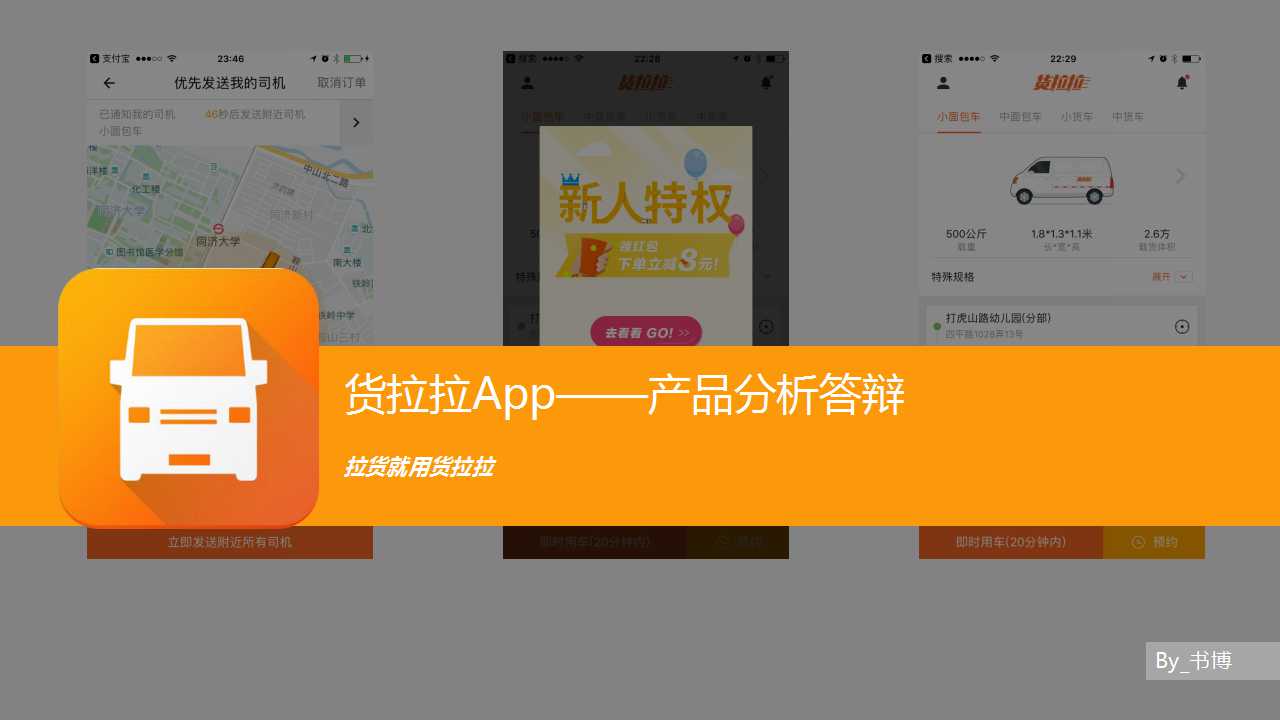
Product name: cargo Lala version: 3.8 device: iphone6s
Slogan: Pull the goods with a cargo lesbian.
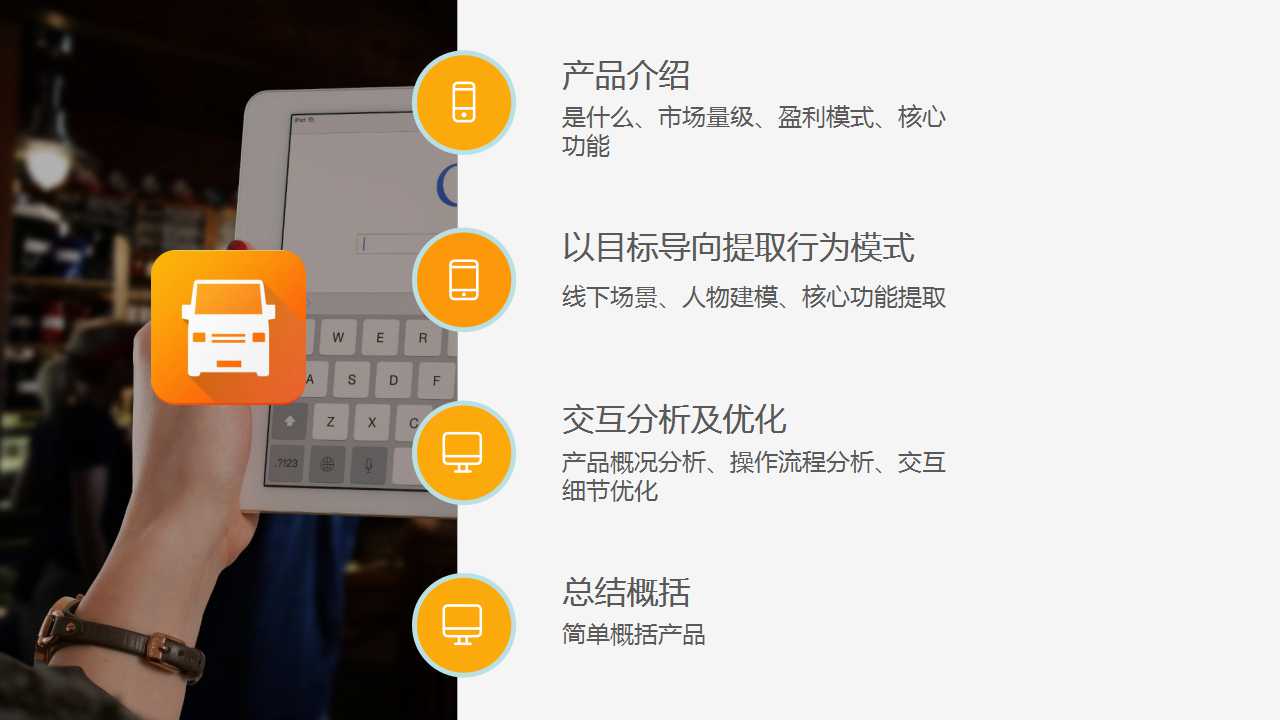
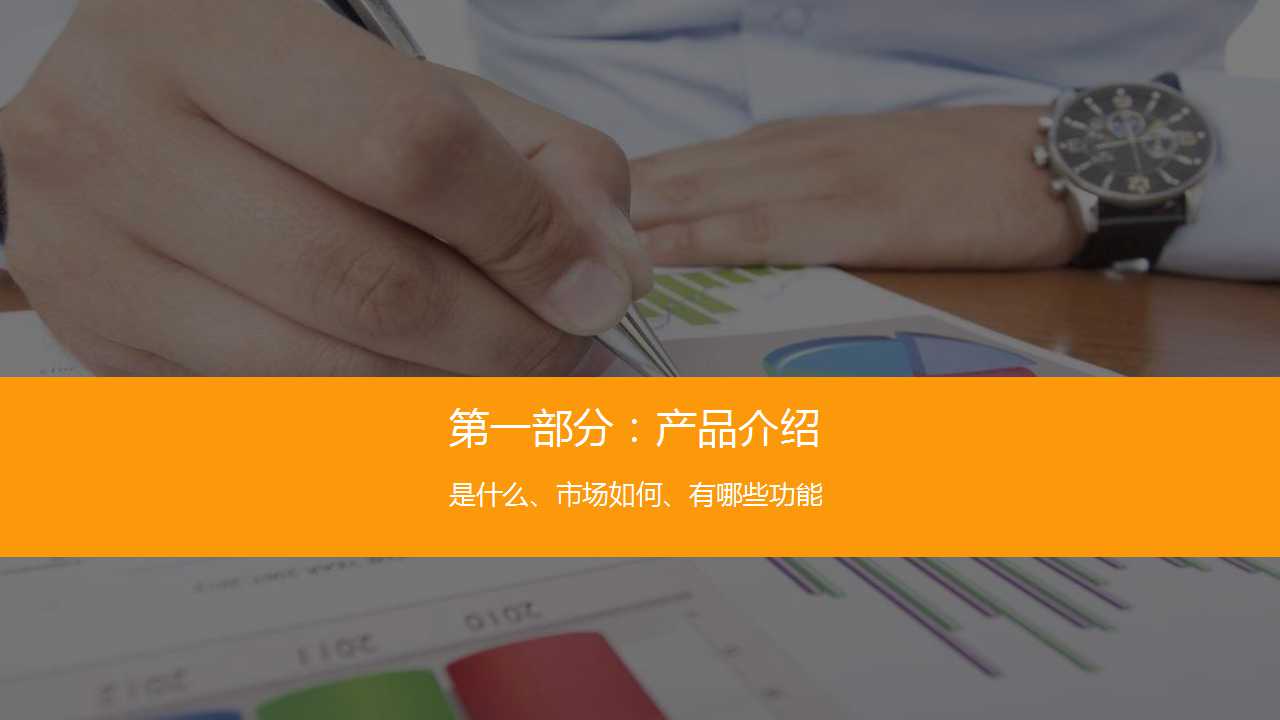
First of all, let’s look at the first part of the product introduction. First of all, what kind of product is the cargo Lala and what problems are solved for users.
From the product positioning, concept, characteristics and other elements, we can sum up the cargo Lala in one sentence: there is only one cargo Lala.City Instant Vehicle Freight Platform, mainly to solve the same cityFreight demand (users) and freight resources (cars and drivers)The problem of poor matching.
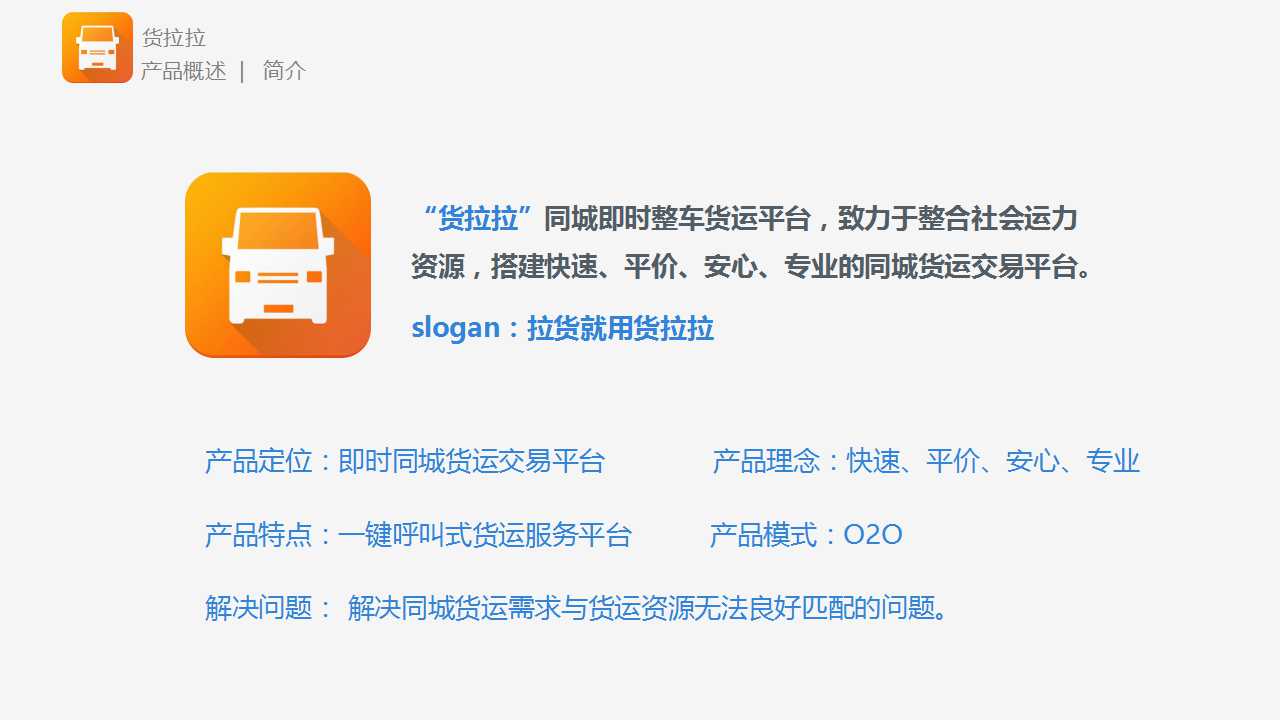
What achievements have the cargo cheerleaders made? In 13 years, she set up a cargo Lala, and in 14 years, she entered Southeast Asia and China. In 15 to 17 years, financing was raised for four times, and hundreds of millions of yuan was raised, which opened cities, the number of drivers and the number of users, which was also very powerful in the market.
Not only that, cargo Lala is the only freight enterprise in the same city in China that insists on the double-track development at home and abroad.
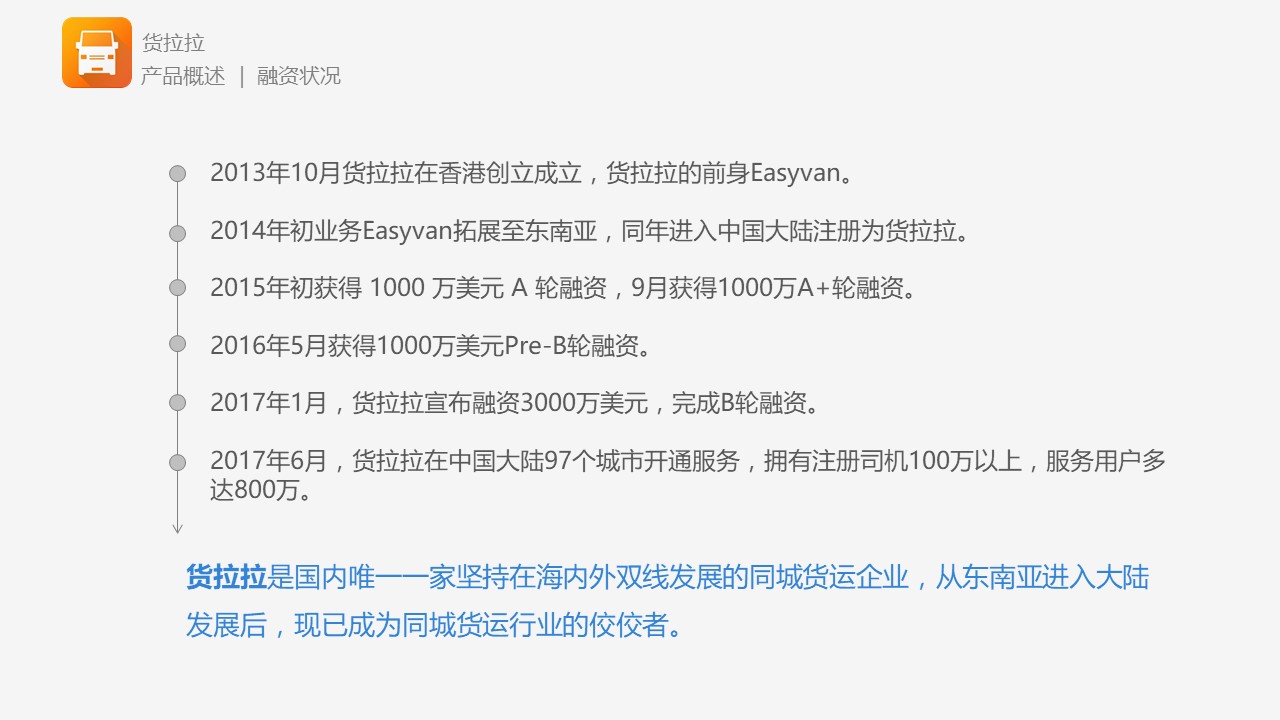
After making a brief introduction to cargo Lala, we understand that cargo Lala is a product of same-city freight. What exactly is same-city freight?
Intra-city freight is to solve the last mile of urban freight, provide near or short-distance transportation, and meet the requirements of "single receipt of multiple products" and "multi-receipt of single products". The main targets of intra-city freight are moving users at C end and small users at B end (self-employed and small shops).
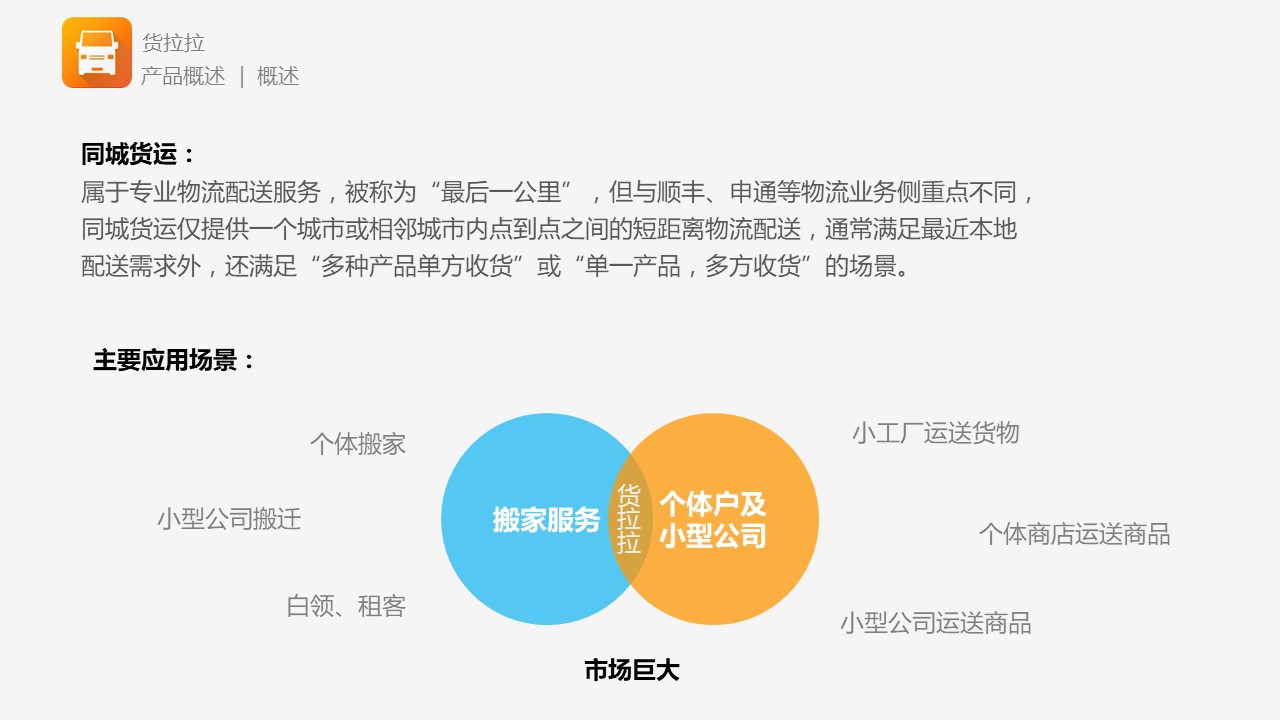
This year’s logistics report points out that express delivery in the same city will maintain a growth rate of 30% in the next five years and reach a market of 200 billion in 2020. The rapid growth of express delivery business in the same city also provides many opportunities for freight transportation in the same city.
Secondly, the moving market: the rental market in first-and second-tier cities is booming. According to the white paper released by 58 cities, tenants who move once every six months to two years on average have become the main components of the rental market, and moving accounts for the largest proportion of the traditional home service frequently used by mobile phone users.
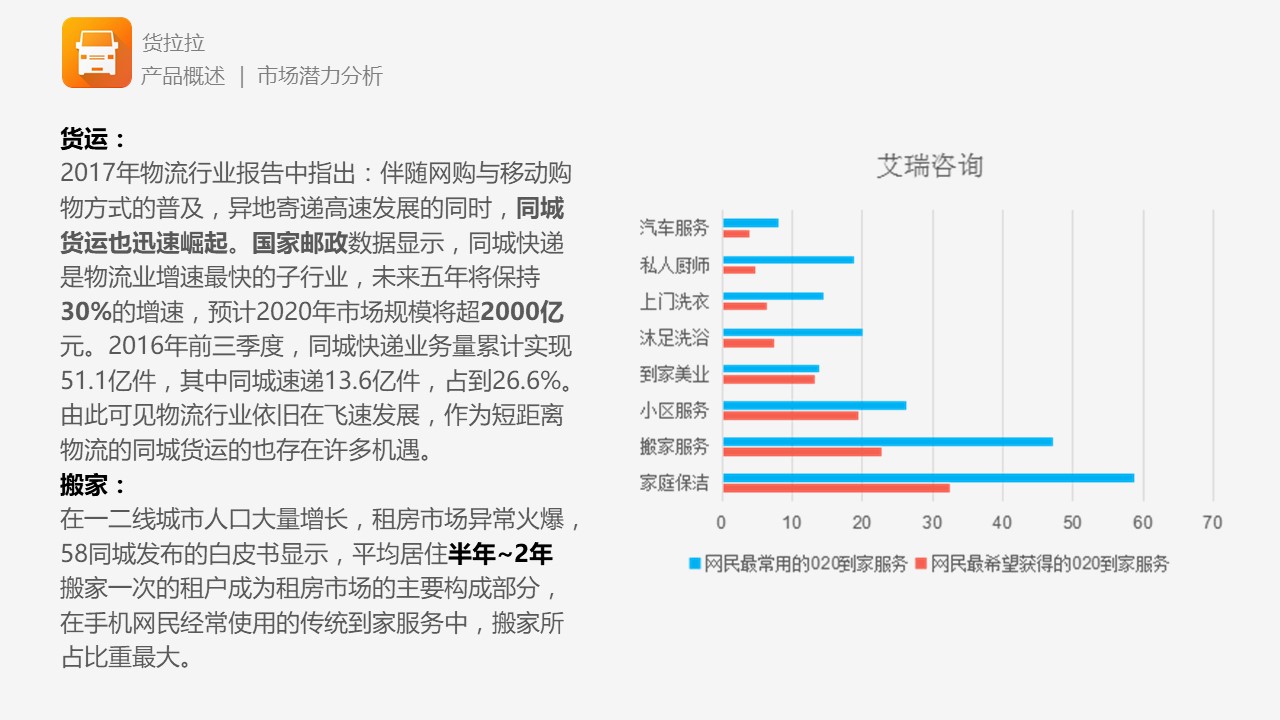
Users, who need to pay freight charges, have to go through the platform, and the platform provides them with freight resources and carries out security guarantee. Drivers need to pay 1000 yuan security money when they stay in the platform, and they can purchase grade privileges, which can be divided into 399 and 699 per month. Both of these privileges can get high-quality orders first. Drivers can earn money by accepting orders on the platform. Then the revenue model of freight forwarding is: security fund pool, grade charge and other enterprise service fees.
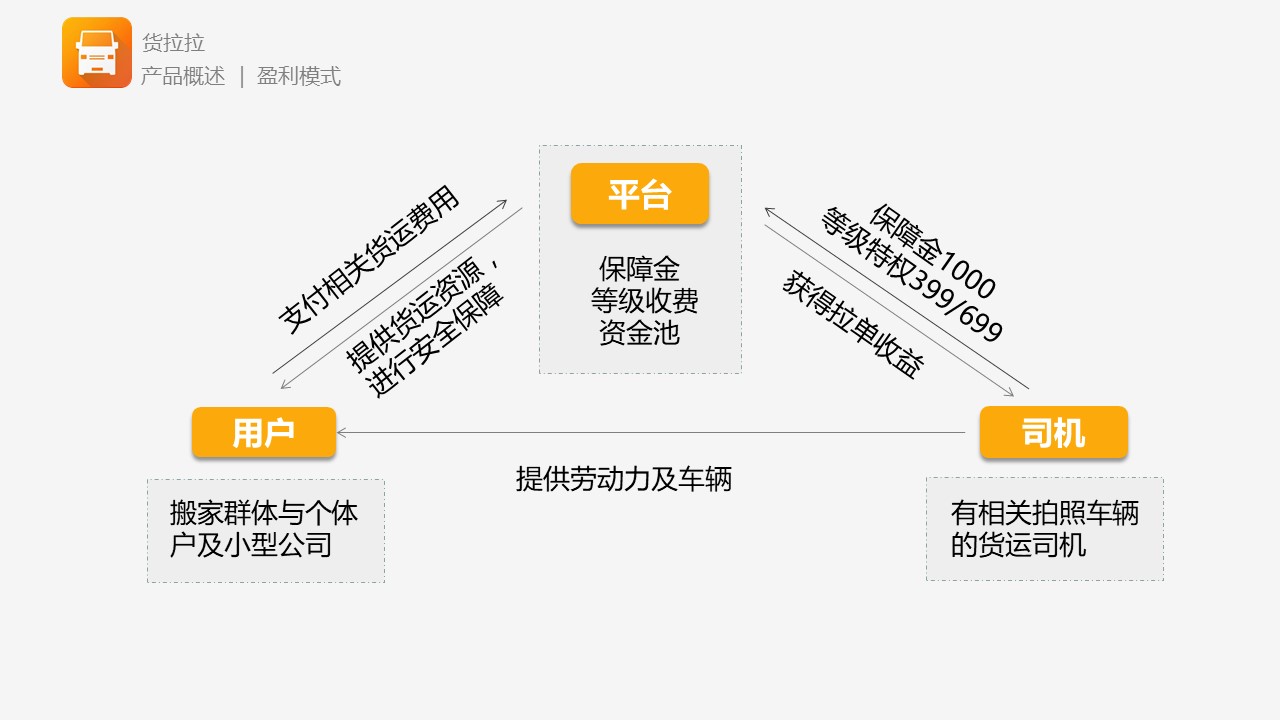
From the function, we can see that the cargo Lala has realized the core demands of users, and the core functions are basically there. The first screen of the cargo Lala guides users to place orders directly, which also fully reflects the actions.Importance of tool products to efficiency. From the perspective of the whole information architecture, flat architecture for user operation efficiency.There has also been further improvement. The main functions of the product focus on the home page and personal center. The bulletin board mainly shows some activities and notices. (as shown below)
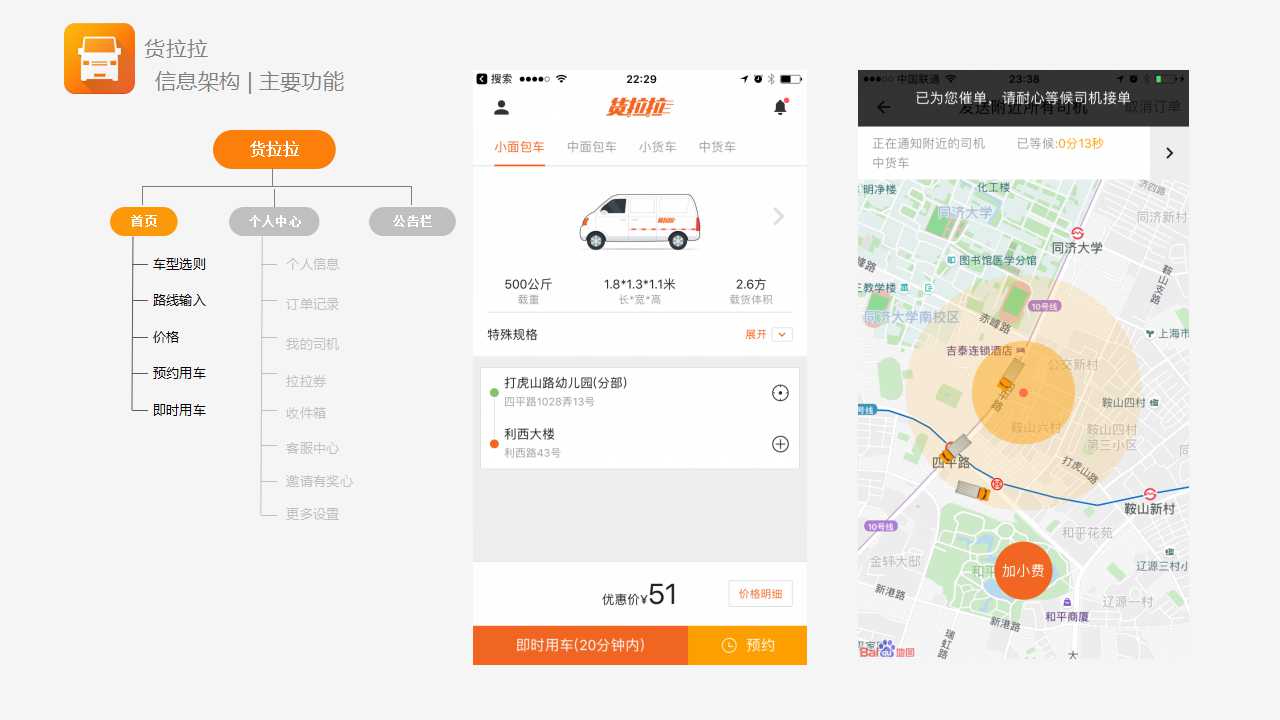
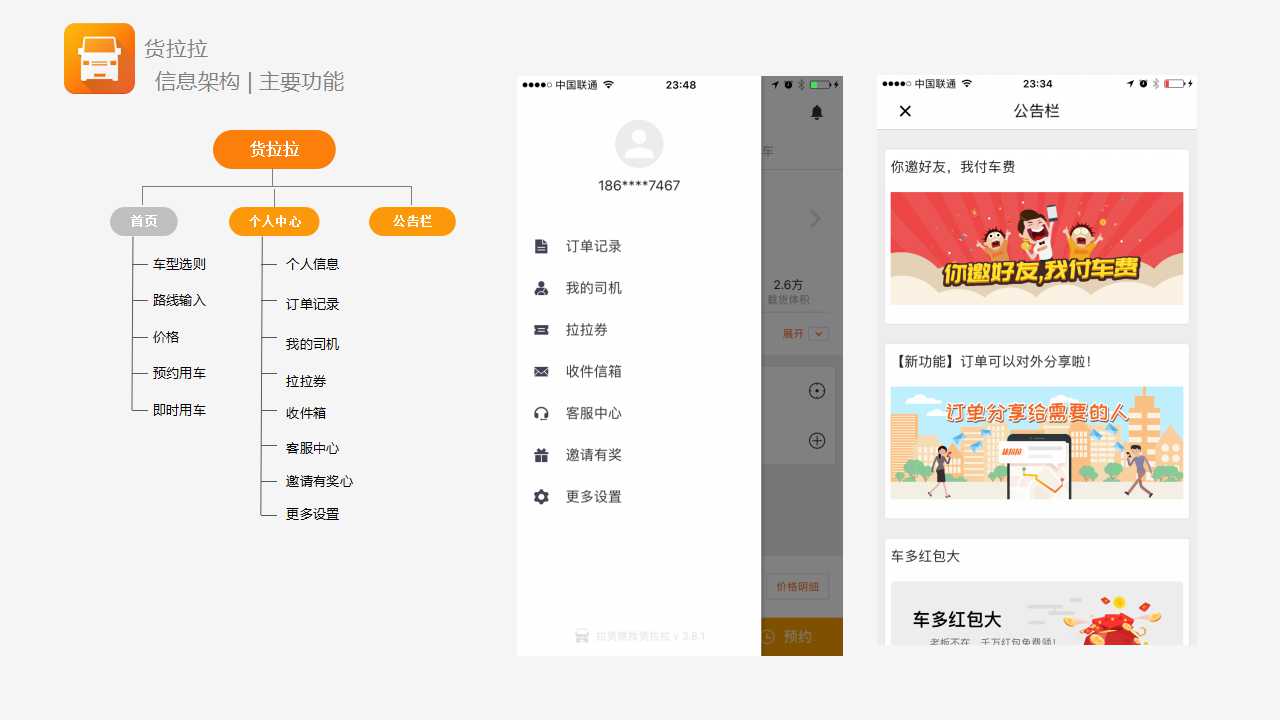
After understanding the freight market, the two core user groups of freight in the same city, and the core functions of freight pull, let’s deeply analyze the target users together, and take goal-oriented as the principle to extract the user’s behavior pattern.
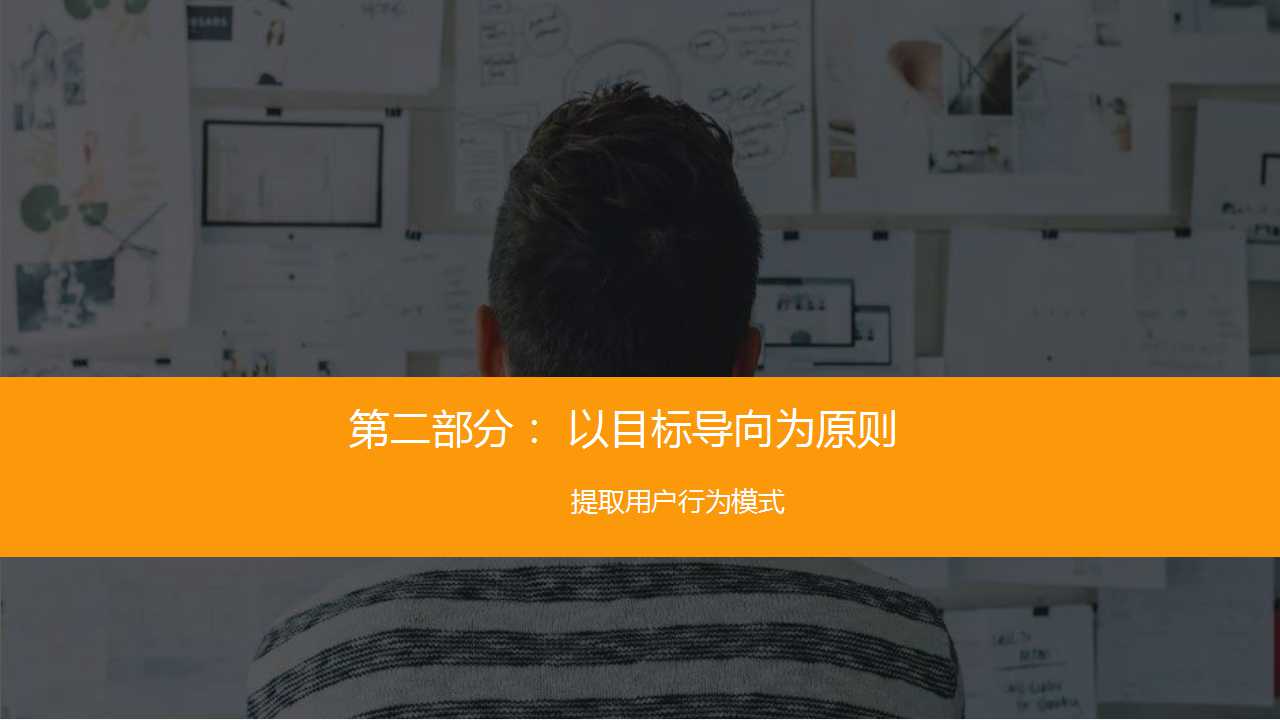
When customers have freight demand, they need to find freight drivers. In this process, customers will encounter various troubles such as hard to find, high price, opacity, insecurity and uneven drivers. Even if you find a freight company, you should make an appointment 1-2 days in advance. At this time, the freight company will dispatch drivers to transport the goods.
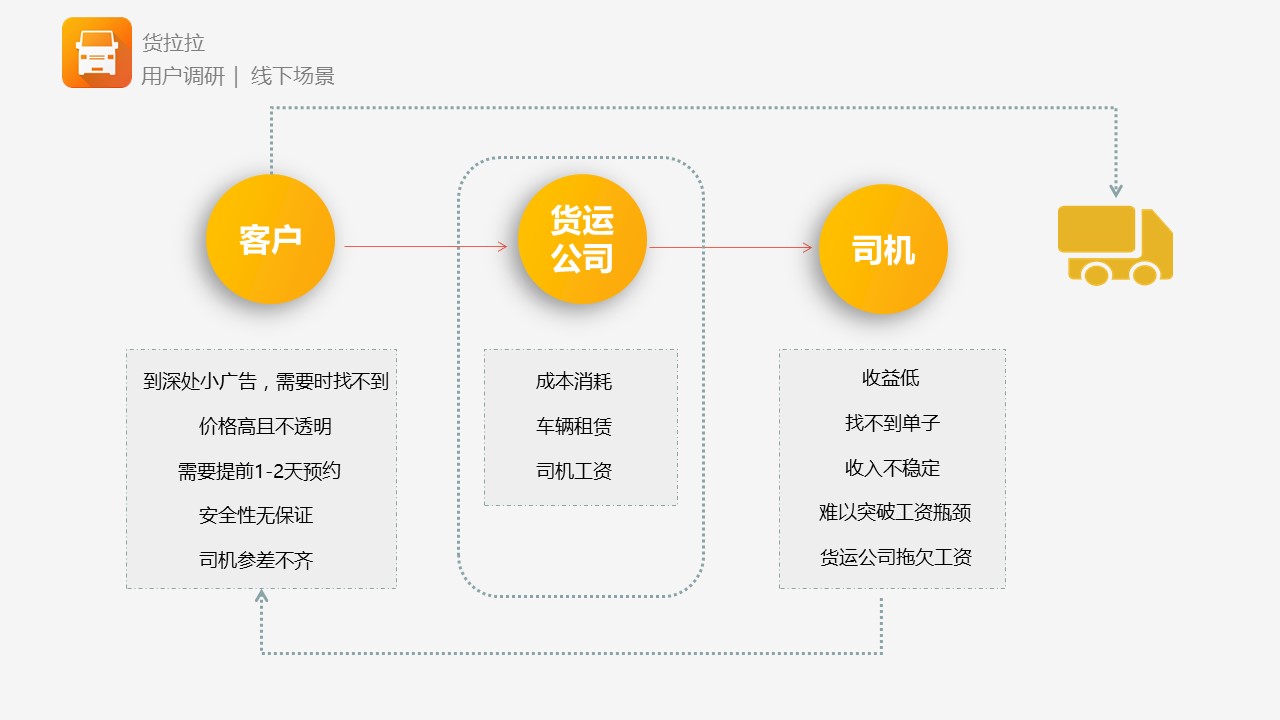
In the whole process, the freight company will cause a partCost consumptionFor example, car rental, driver’s salary, venue rental and so on, this part is actually inConsume the driver’s profitAt the same time, the cost of user payment has also increased. The freight company finds the driver and the driver communicates with the user to complete the order. For drivers, problems such as low income, difficulty in taking orders, unstable income, difficulty in breaking through the wage bottleneck, and arrears of wages by freight companies also appear everywhere.
DeintermediationIt is what some other freight platforms, such as cargo Lala, do. Users directly connect with drivers through the platform to complete the transaction.
Users want to save time, money, worry, effort and security in the process of freight transportation. In this large scale, we deeply explore the needs of users through user research.
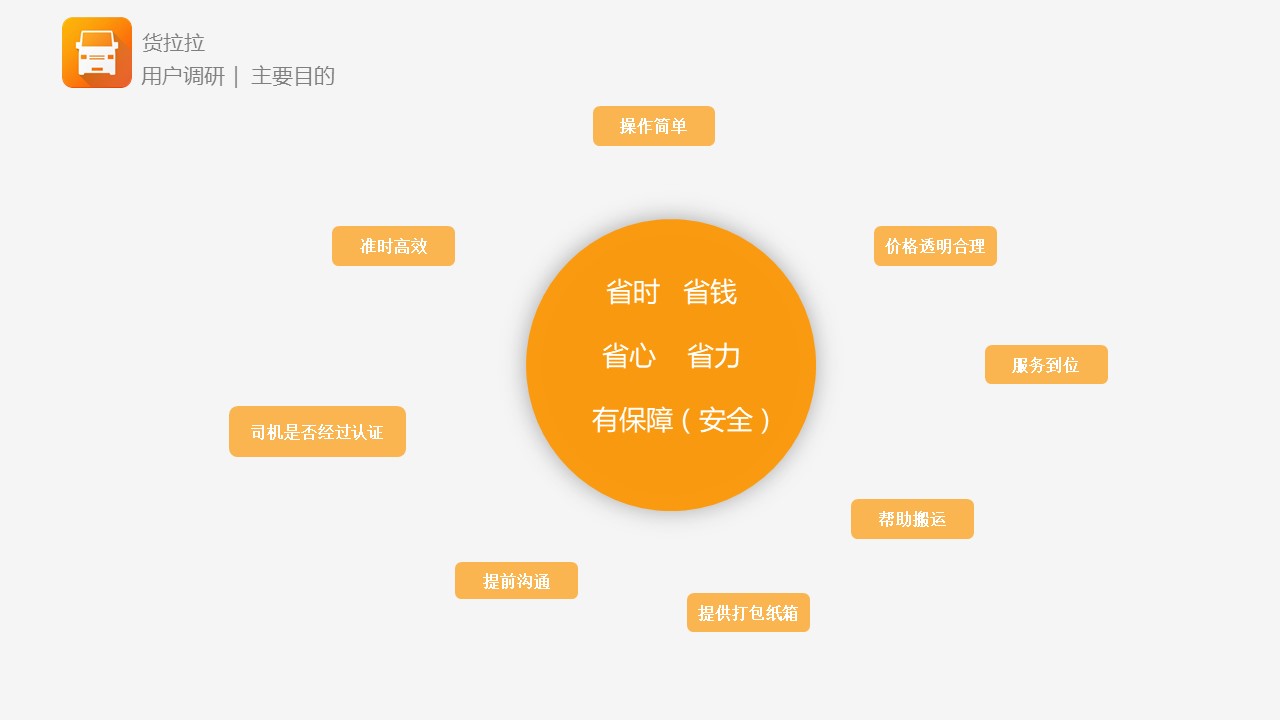
Moving group:
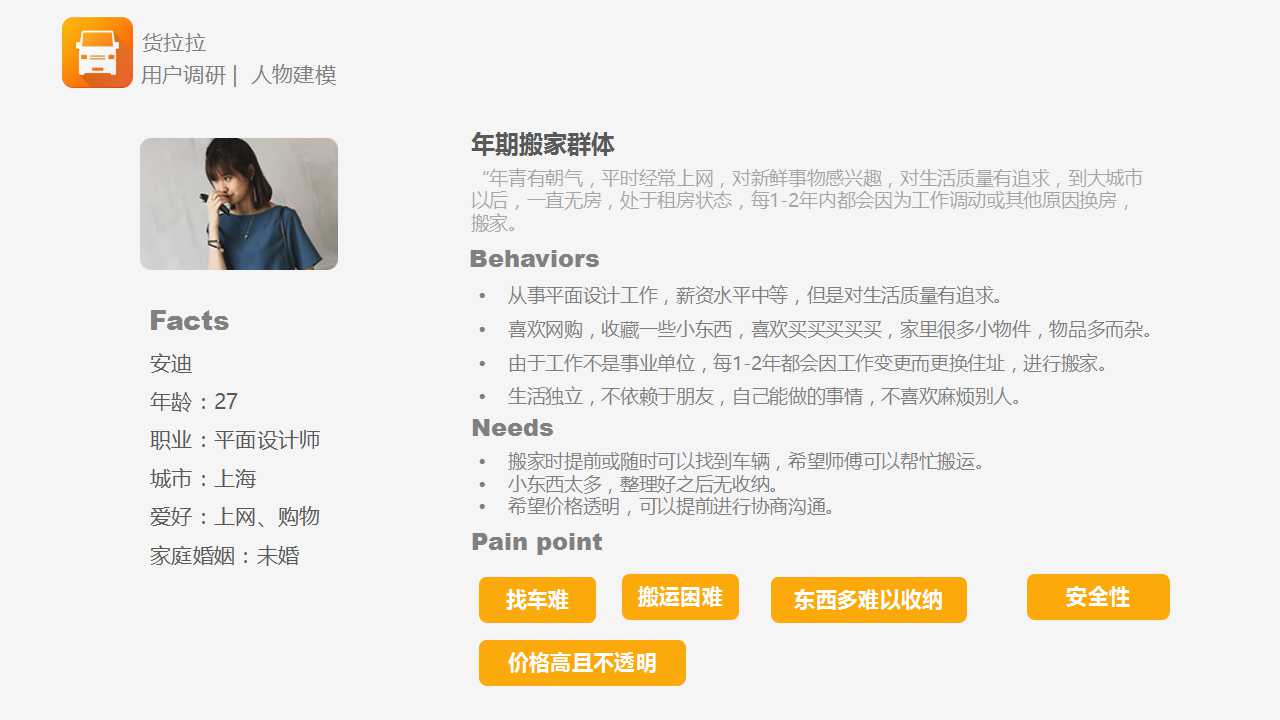
Self-employed and small companies:
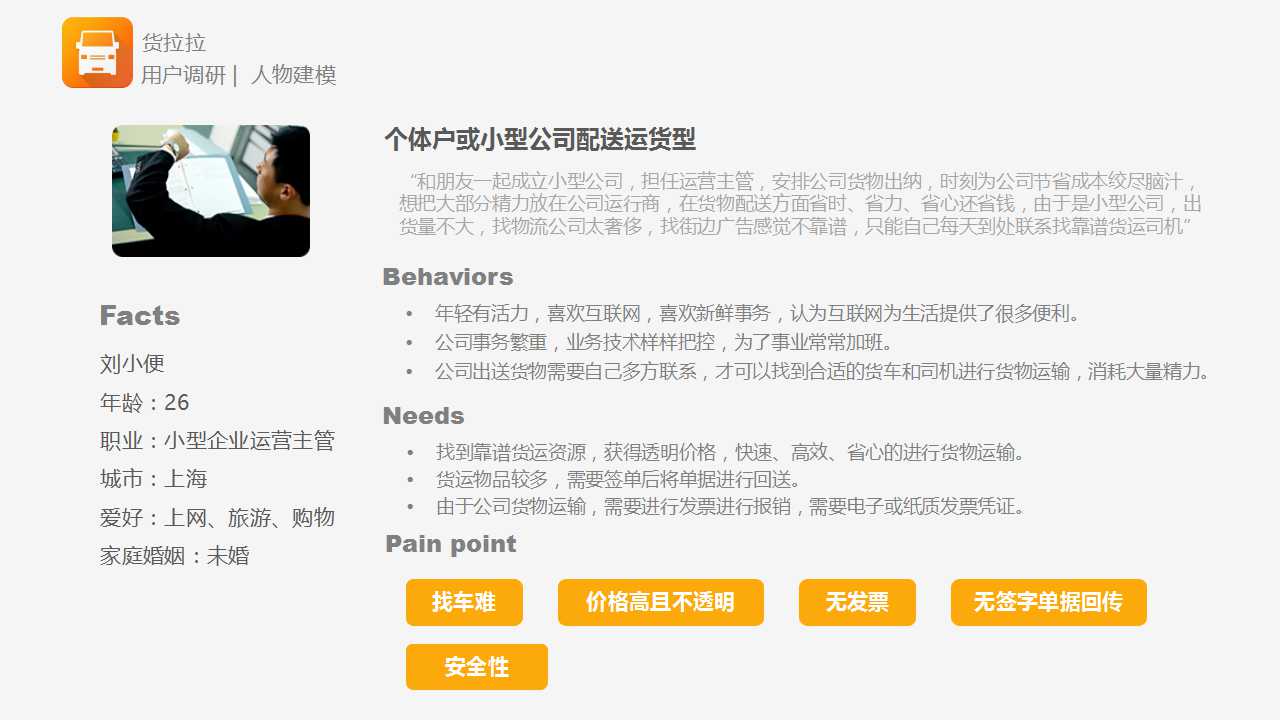
According to the requirements extracted from the character model, the function cloud map is derived. Instant calling and car reservation bear the brunt, and the collection of prices and related routes are also important functions for users. Our next interactive optimization will also be carried out in these key functions.
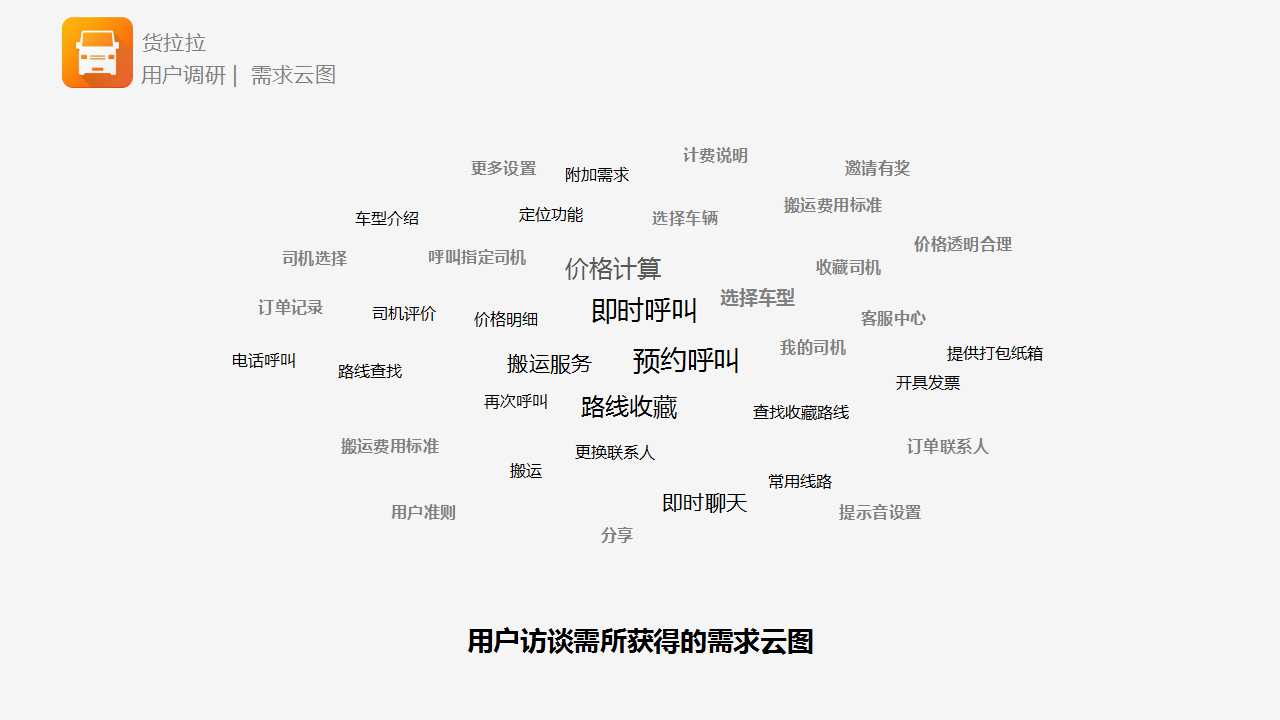
Now, the functions are divided according to different groups of people, so that we can see more clearly what functions the cargo lesbian has done for these two groups, or what functions should be added. After that, we will model the scene according to our functional classification.
Functions corresponding to common requirements:
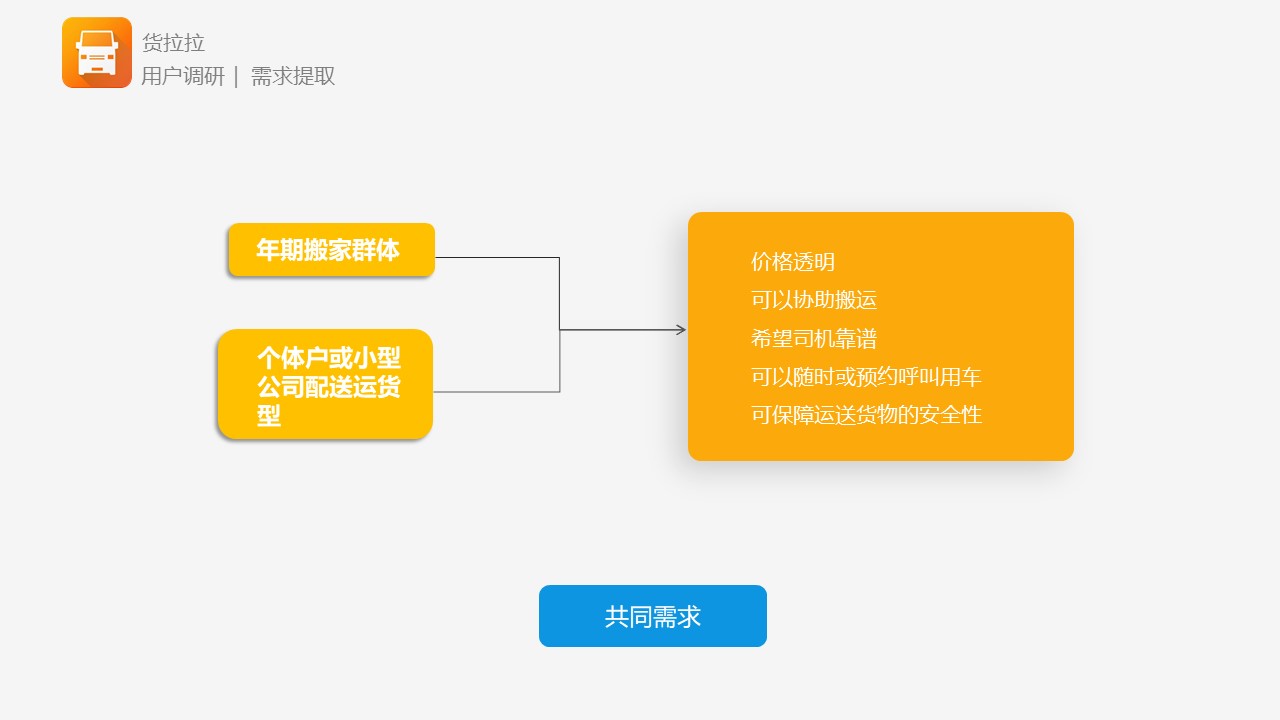
Functions corresponding to different requirements:
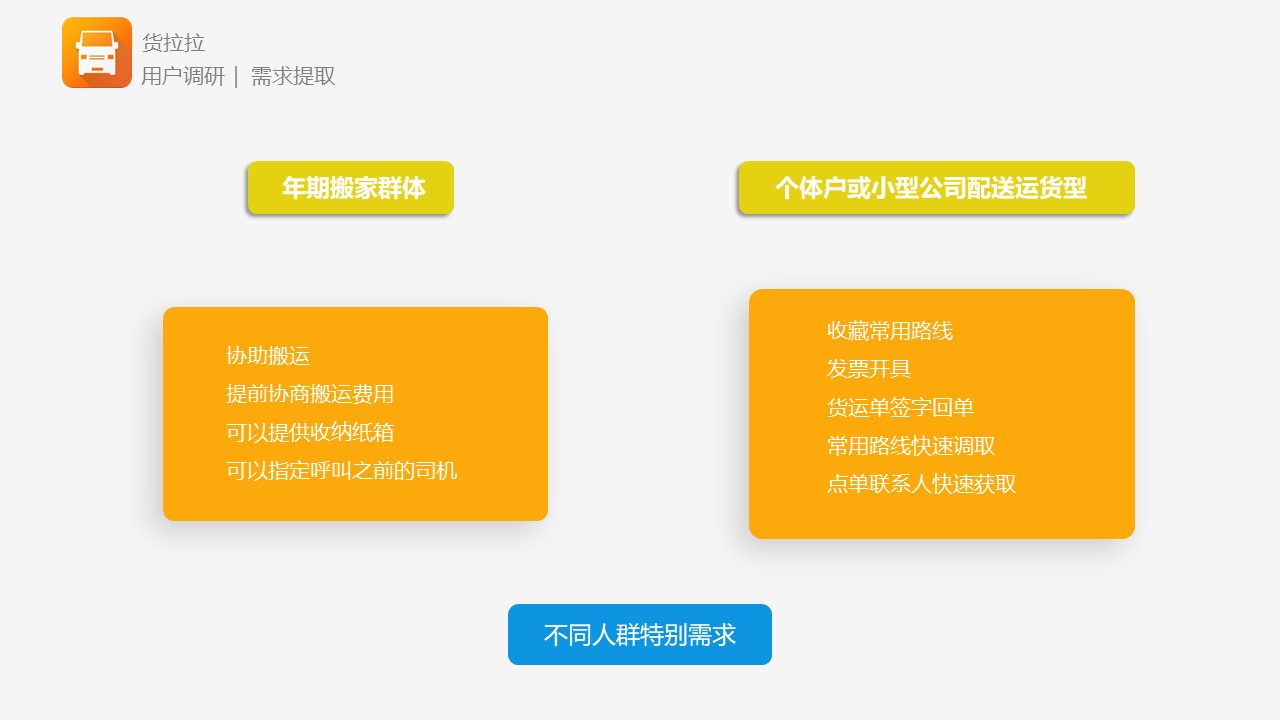
Young moving groups use scene modeling.
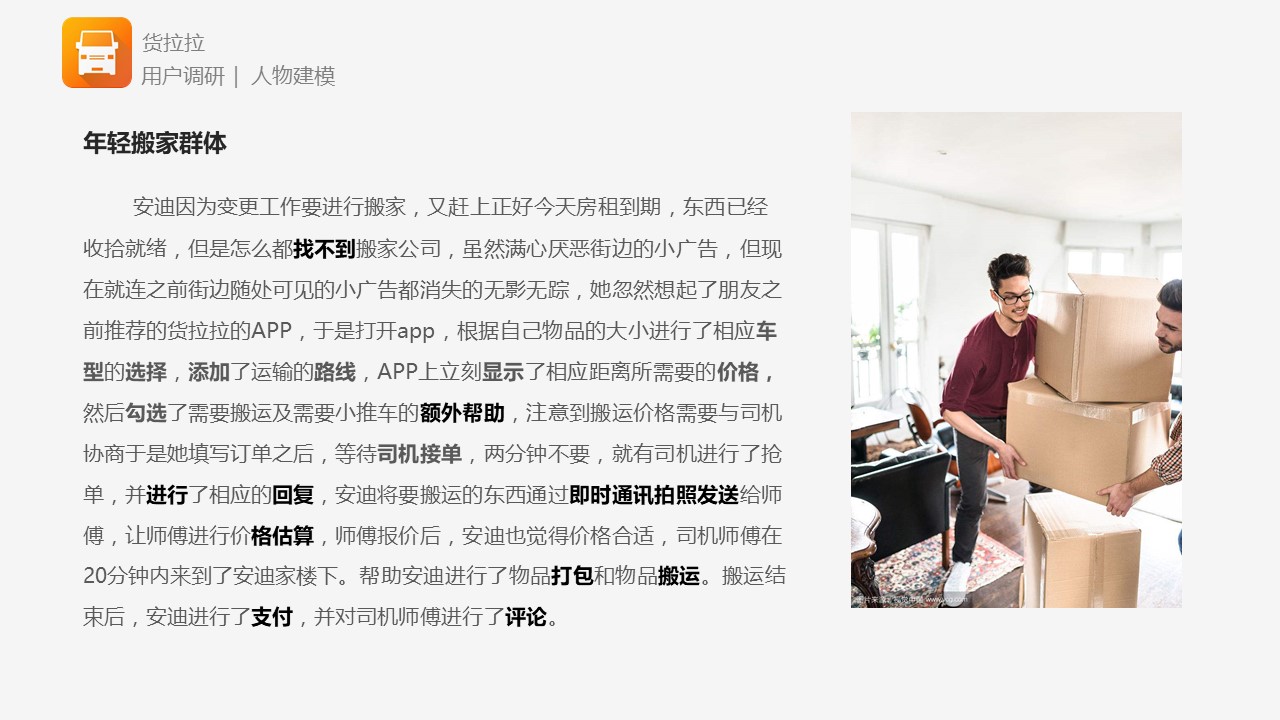
Scenario modeling of small B-end user groups
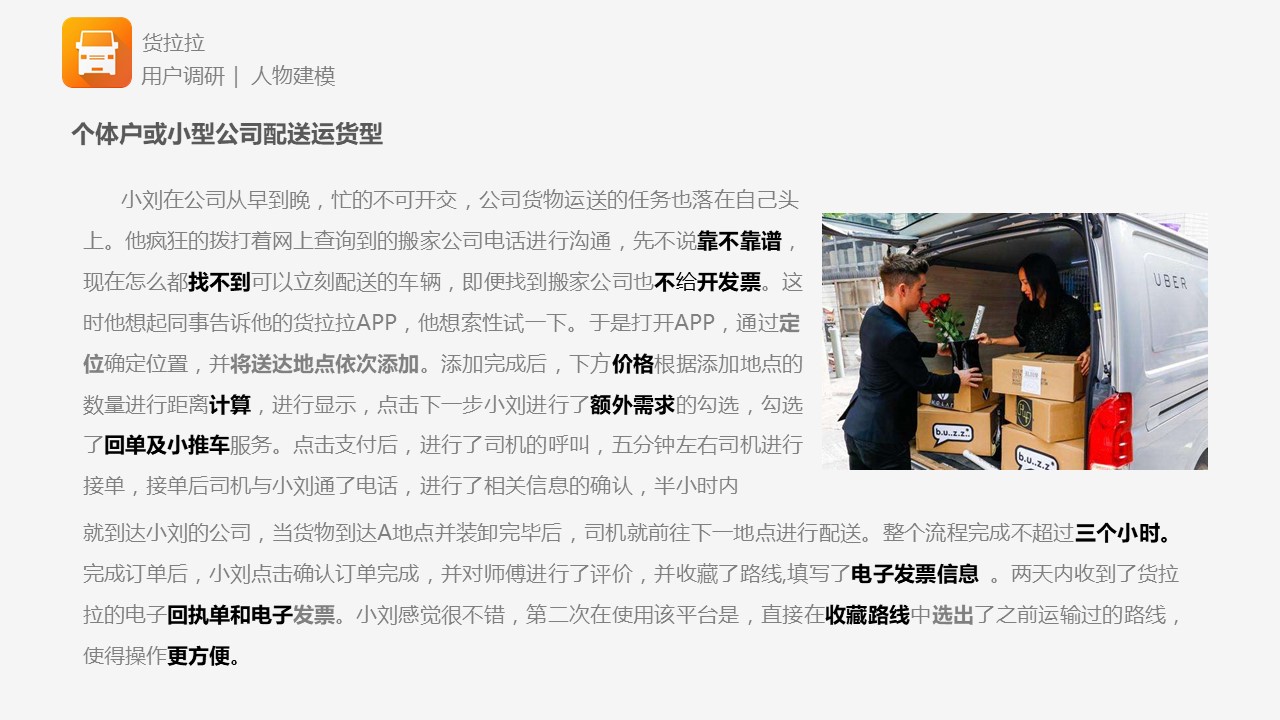
We have talked so much through investigation and modeling, and then we will explore further.How do cargo cheerleaders satisfy these scenarios?Yes, what are the problems? We will also optimize the core functions and processes in our products based on research and character modeling.
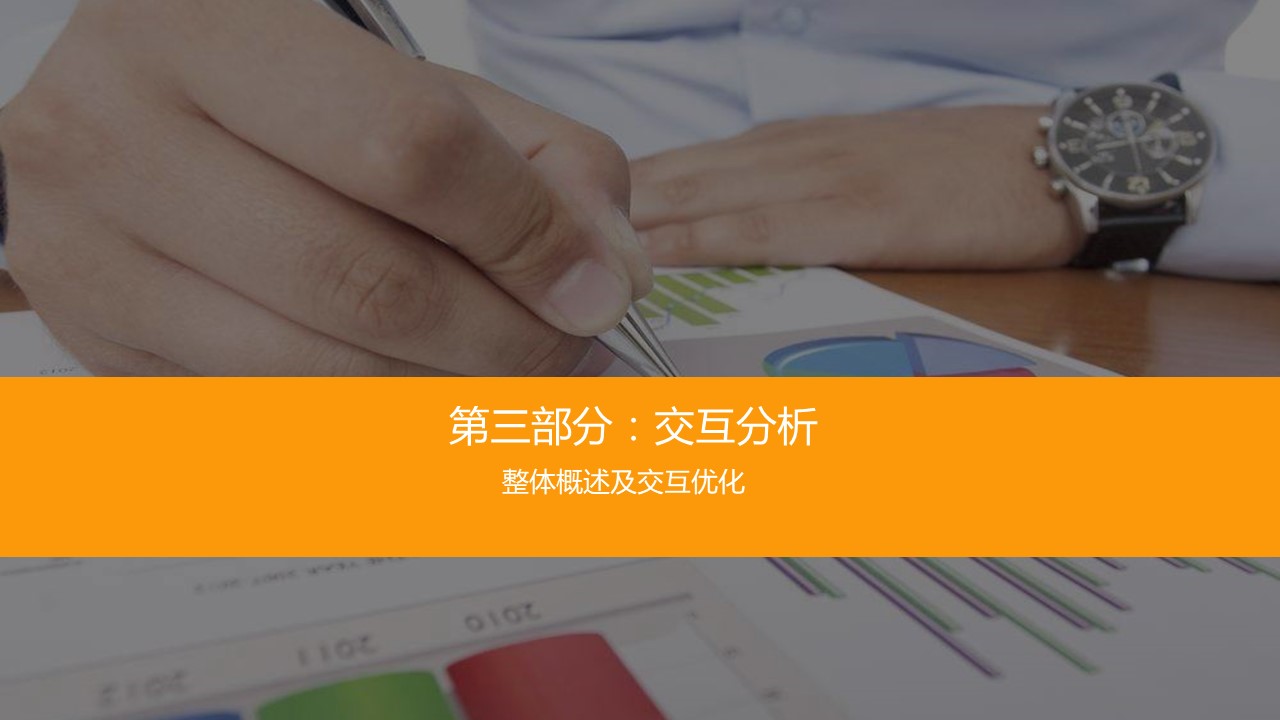
The whole product is light, easy to use, the core process can meet the needs of users, and the consistency is not bad, but we know that there is no best but better. I will find some places that are doing well and what needs to be improved to explain to you.
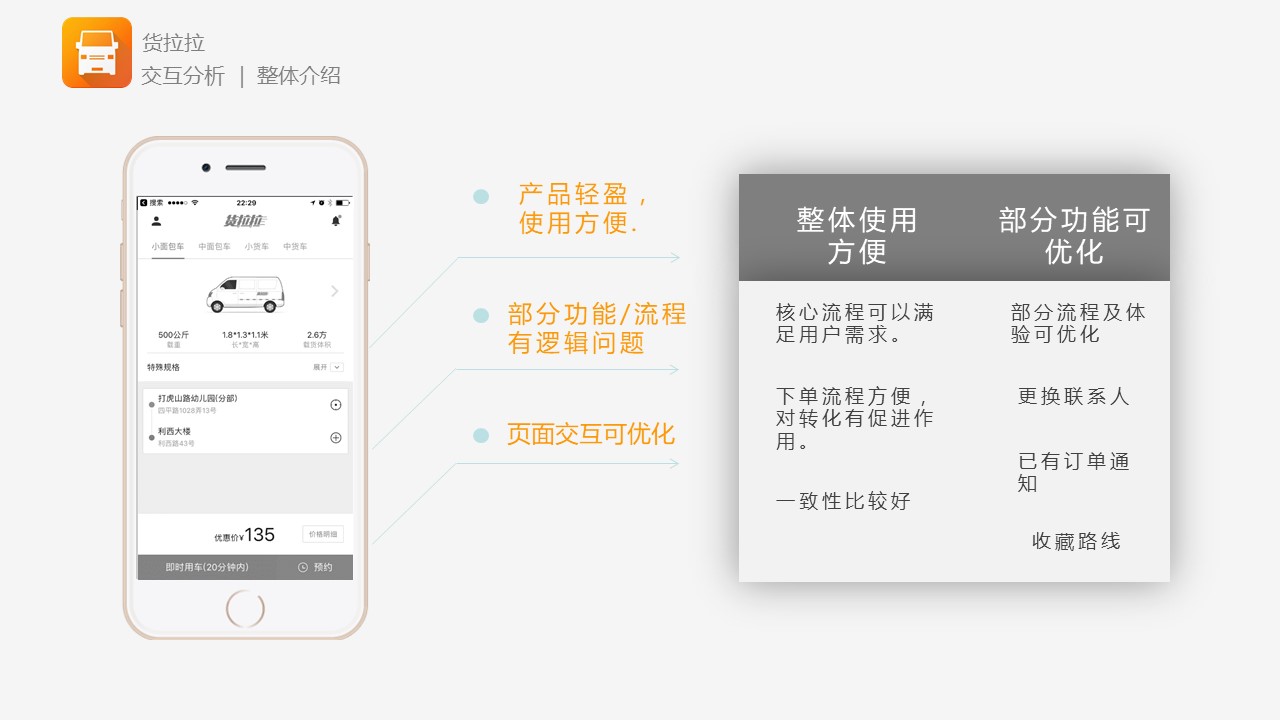
First of all, let’s look at the most core page, the first screen, after the first screen is opened, the three elements of the first screen, who I am (the logo of the cargo lesbian), what content I have (the choice of the car type) and what content attracts me (the price display), so there is nothing to talk about, which is very wrong here.
With the choice of switching between different models and locations, intelligent calculationbear the costLet users know clearly what they need to spend, and get the most concerned information for users at the first time, which is helpful to improve product orders.Conversion rate
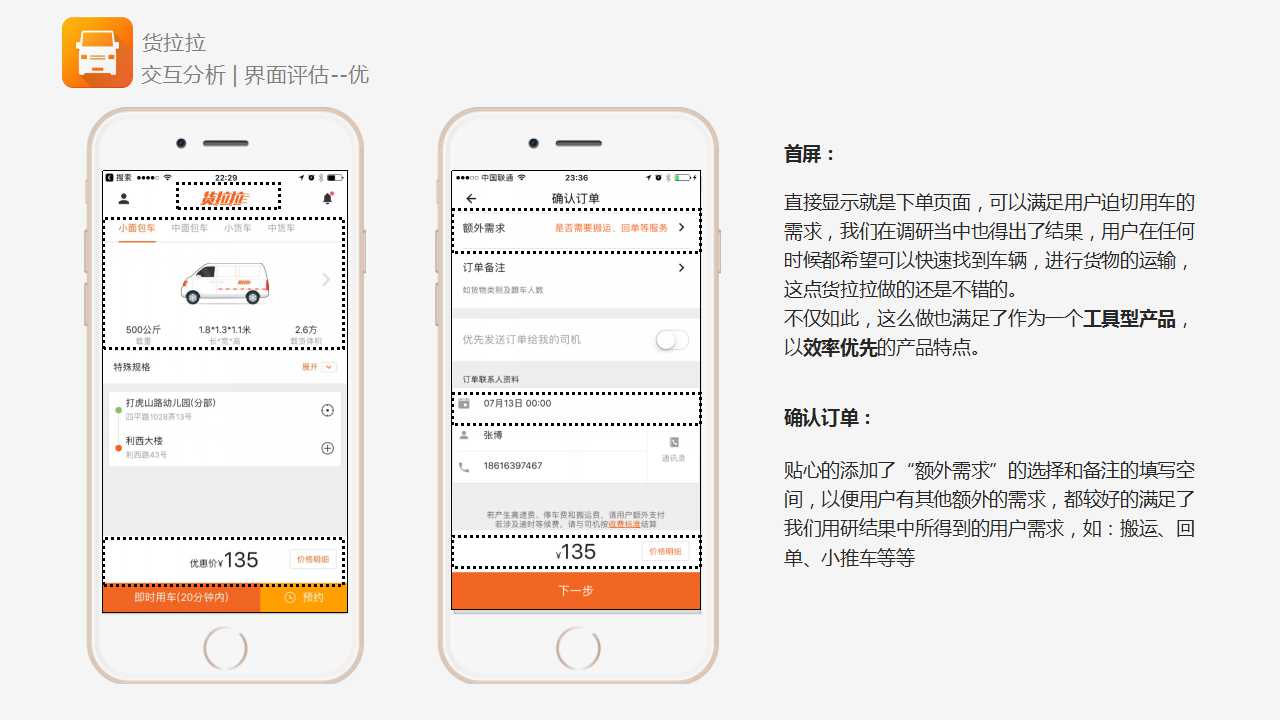
Confirm order page
Intimately added the choice of "extra demand" and the space for filling in notes, so that users have other extra needs, which well meet the results of our research.Users need to carry and other additional services..
Not only that, in this page, the amount used and the delivery time are emphasized again, so that users can have a clearer understanding of the order. All these have promoted the transformation of orders.
And as can be seen from the above figure, the product designconsistencyRelatively speaking, it is still good.
Send all nearby drivers page:
After booking the vehicle, while waiting for the driver and the user waiting, the radar scanning gives the user a sense of sight and a good impression in terms of sensory attraction. It also relieves the anxiety of users in the waiting process.
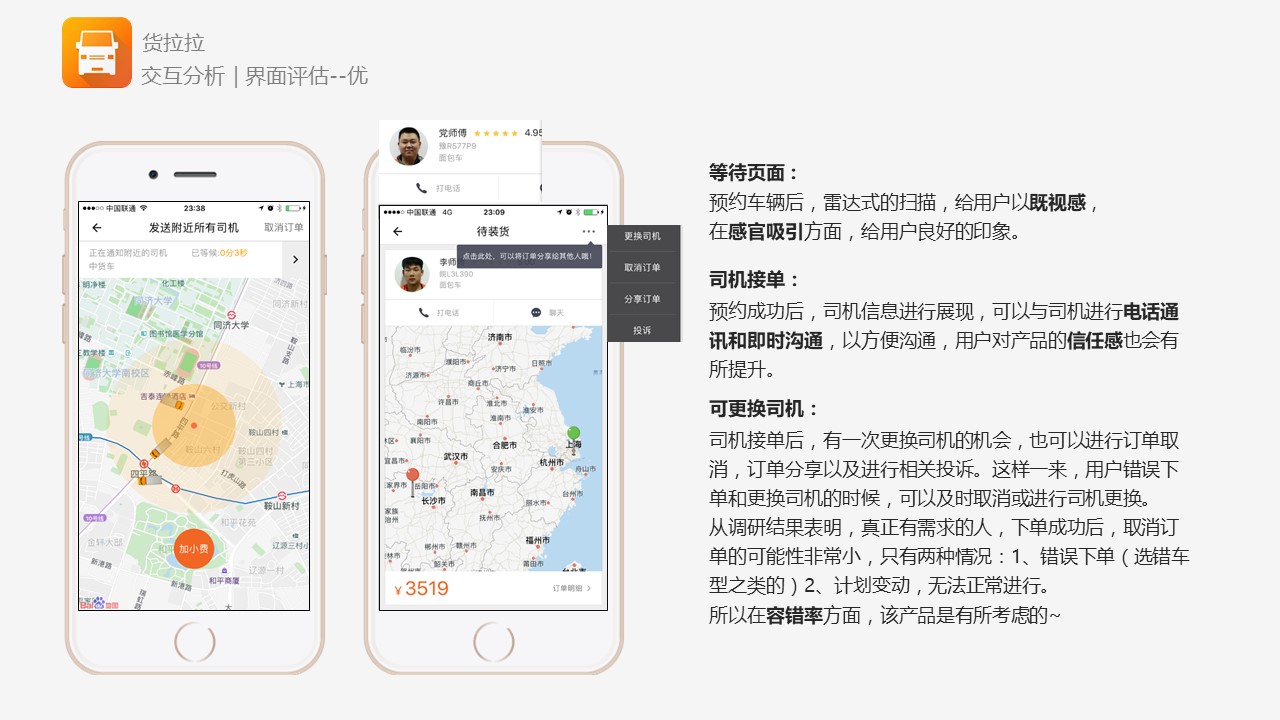
"pending shipment" page
After the driver takes the order, the driver’s information is displayed, such as the driver’s star score, license plate number, car type and other information. These functions have solved the problem in our character model: user.Worried about the driver’s irregular attendancePain points in other aspects. Telephone communication and instant communication with drivers will further enhance the trust of users, further enhance the transformation and increase the sense of experience.
The contents displayed on the right are: drivers can be changed, orders can be cancelled, orders and complaints can be shared, and it can be seen that the product is also thoughtful about fault tolerance (orders can be cancelled or changed in case of wrong orders or special circumstances) ~
We know that moving is a relatively low-frequency behavior, and there are moving groups, which are one of the main groups in freight transportation in the same city, so we have to think about how to get more new users. When we use the product, before we open the APP to place an order, there will be an activity pop-up box that invites friends to activities, and there will also be invitations and prizes in the personal center. The bulletin board has been making unremitting efforts to send some activities and the like. Therefore, the cargo Lala is also making unremitting efforts in pulling new ideas ~
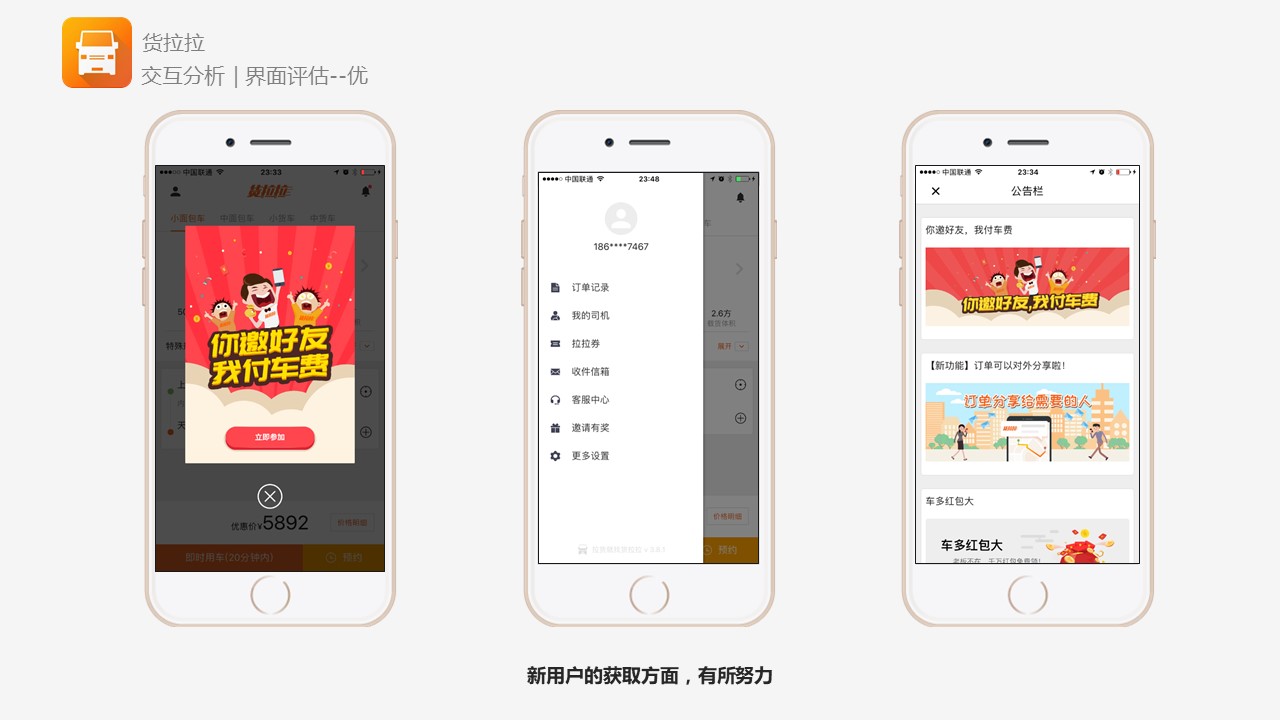
On the whole, cargo Lala has done a relatively good job in core functions. But no one is perfect, and the products are the same. There is no best, only better ~ Let’s look at some shortcomings in the APP.
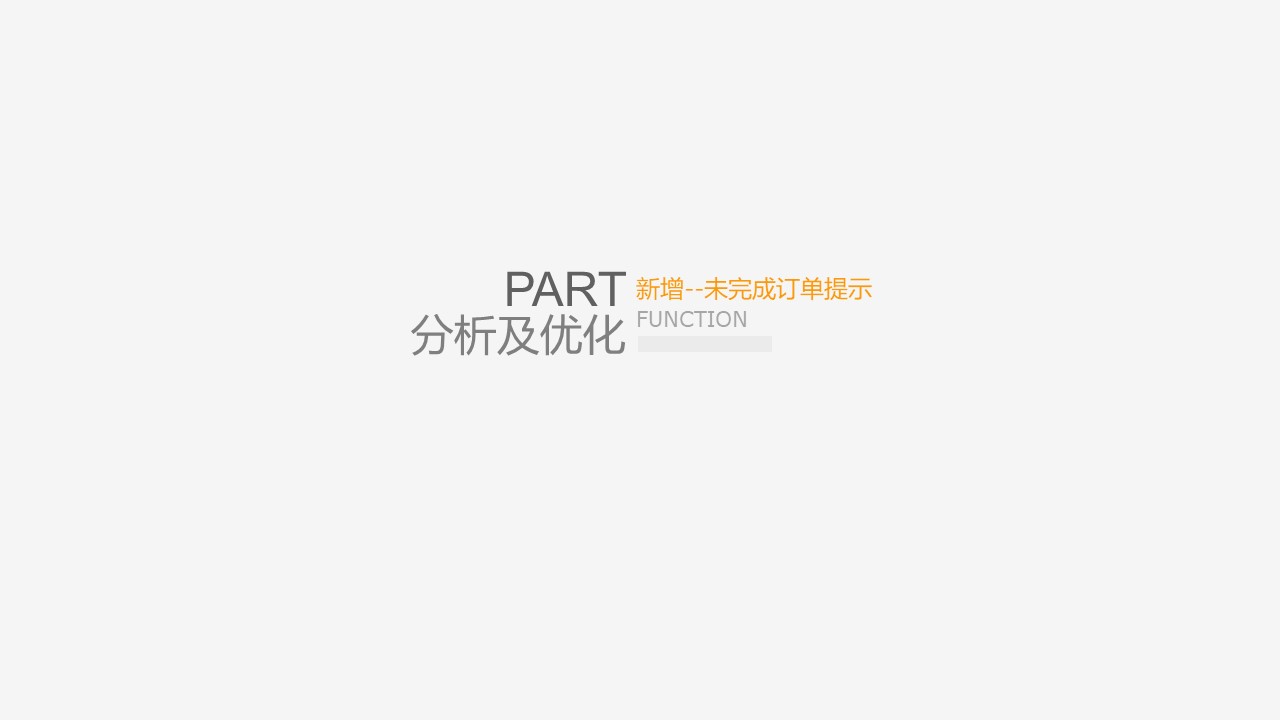
Overall operation process combing
First, after opening the APP and entering the home page, the first step: choose the model–choose the destination; Part II: Select requirements–fill in comments–enter your personal information–click Next; The third part selects the relevant payment method to complete the payment; The fourth step is to enter the waiting page after the payment is completed. (The main flow chart is as follows)
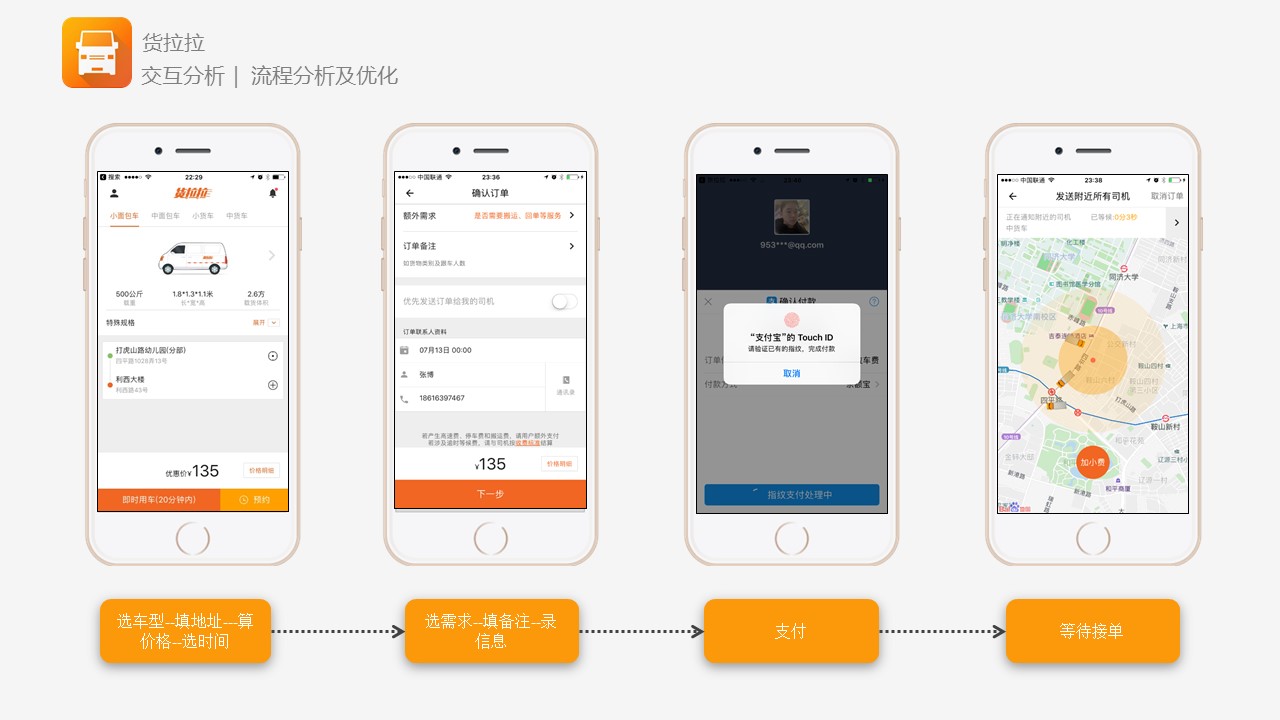
Normally, after waiting for a few minutes, a master will take the order. After taking the order, the master’s information will appear, and relevant communication can be carried out. Then the driver will arrive within the specified time, load and transport. After completing the whole process, click OK to complete the order, complete the freight, and then evaluate the driver. If an invoice is needed, fill in the electronic bill information to complete the whole process.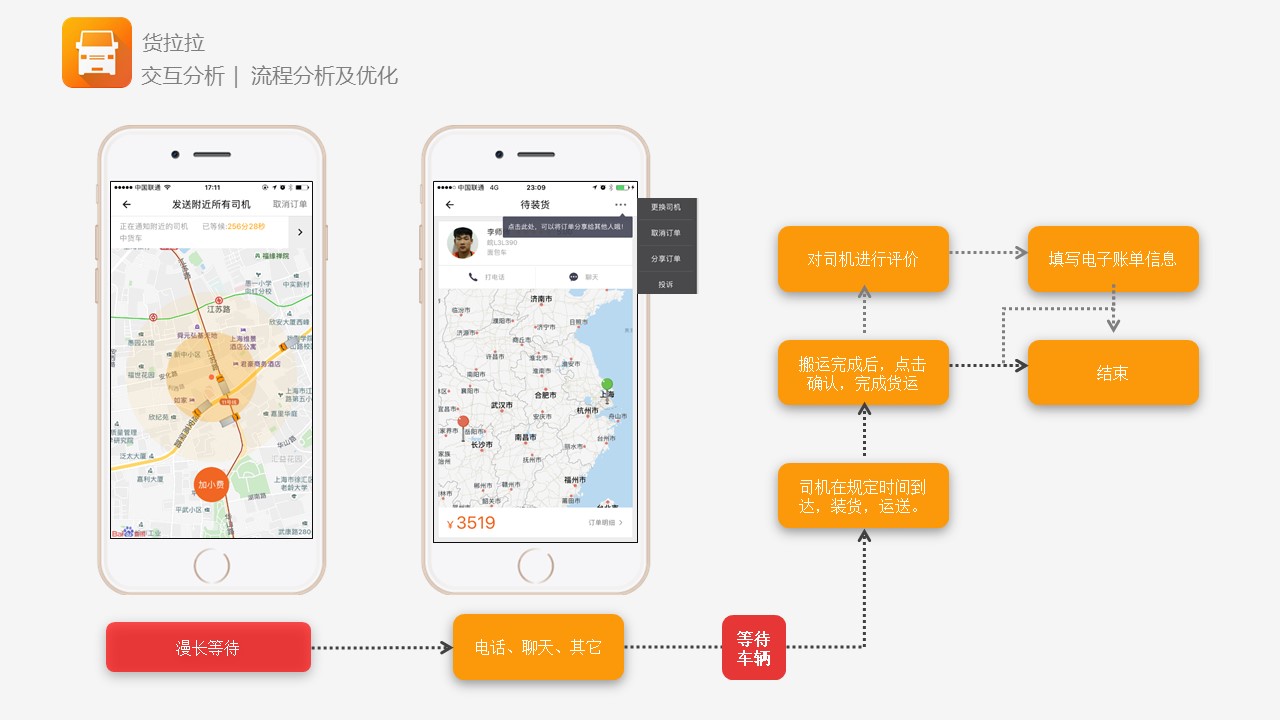
Special circumstances that may occur in this process.
The whole process is perfect, so what should I do when there are special circumstances? For example, after waiting for more than 200 minutes after payment, the driver has not taken the order. Another example: I made an appointment to pick up the goods tomorrow, and the driver will arrive tomorrow. What will the user do during such a long waiting time?
User waiting time and patience research (user waiting scene and behavior analysis)
What will the user do? Wait, we mentioned in the character modeling earlier that we hope to find the freight driver quickly and make a quick match before shipping. If not, what will the user’s psychology be like?
We have done research on the patience of users when they wait.User Waiting Scenarios and Behavior AnalysisAs shown below:
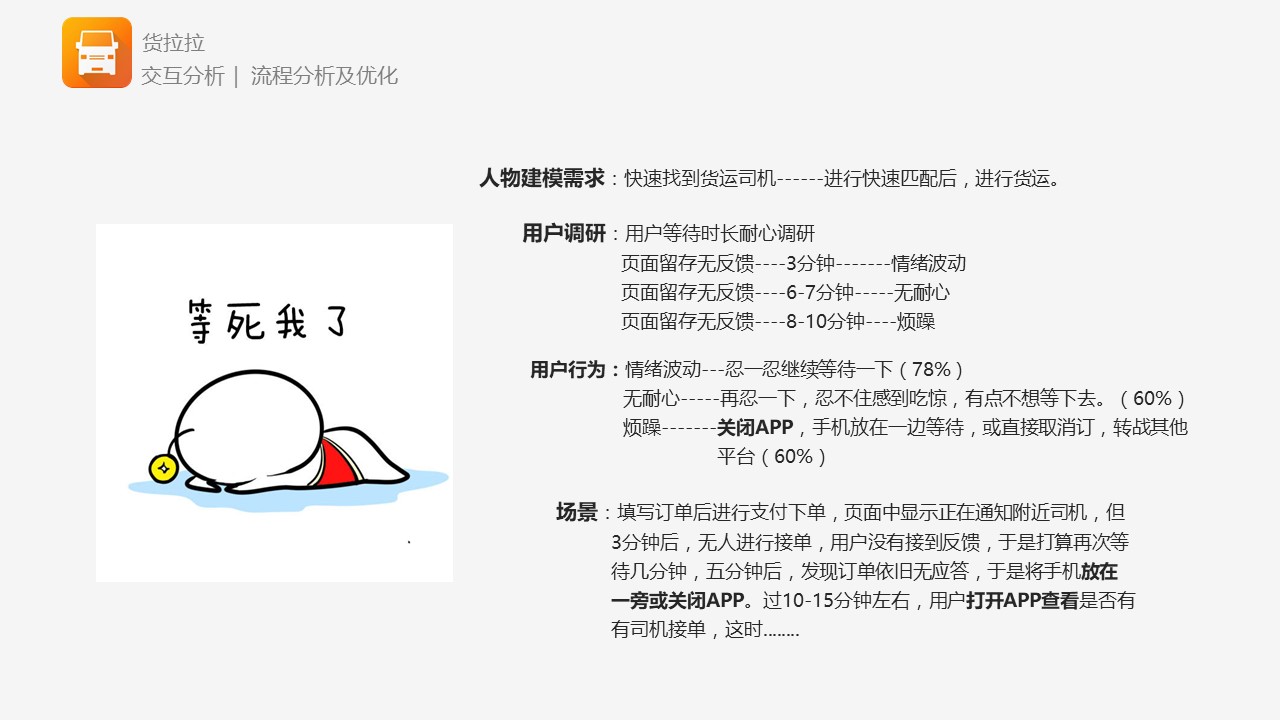
When the page shows that the nearby drivers are being notified, but no one answers the order after three minutes, they may put their mobile phones aside and do other things first, and then open the APP after 10 minutes. This is the behavior pattern we extracted from the investigation. But at this time, what hAPPens when the user picks up the phone again and opens the app?
What hAPPens when you close the app and reopen it?
At this time, after opening the APP, I entered the home page. At the moment, what about the order? Is it gone? Wait that long for nothing? So much information is written in vain. If I really need to move or transport goods, I will consider whether to do it again. Ok, let’s do it again ~
The order was not found. What happened to the new order?
Once again, go through the process just now, fill in the information–complete the information–submit the order–when paying, remind me: "The goods are coming to match the driver for you, please wait a moment".
The deep routine makes the user collapse. Finally, I have to find out where my order is, and I found the order I placed before in the personal center-orders, third-level page.
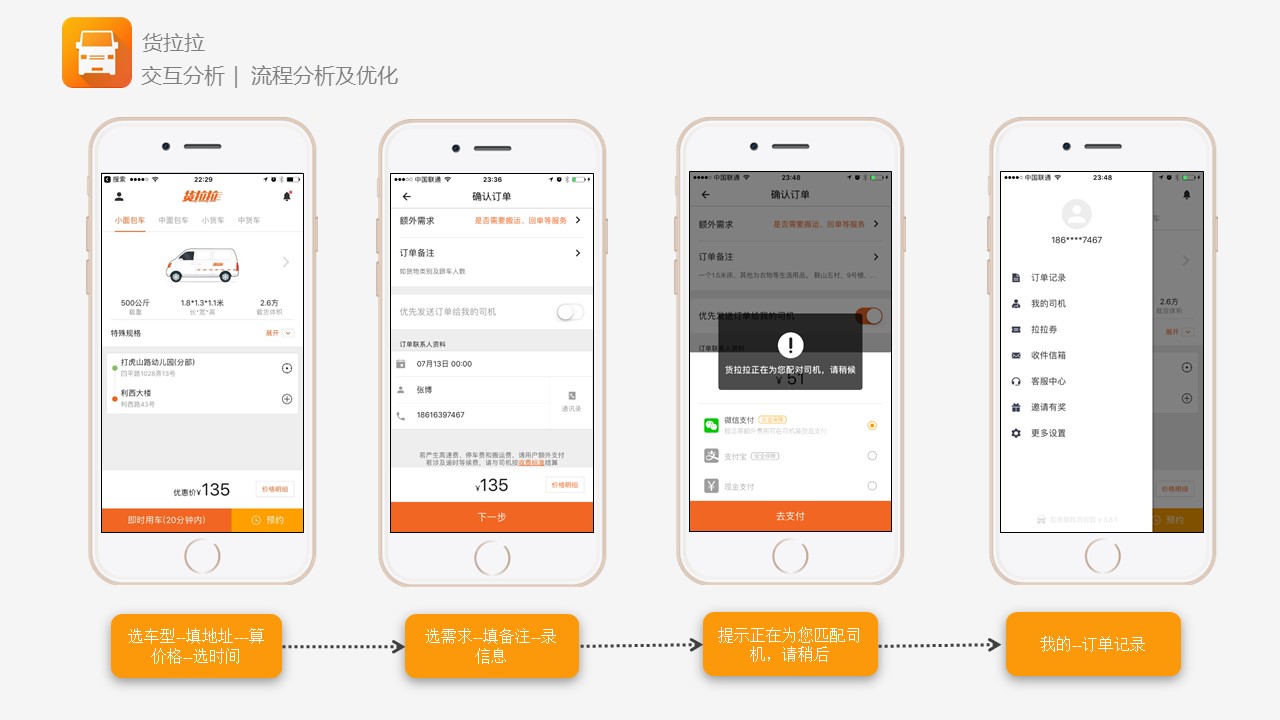
Summarize the problems and propose solutions.
Question:The order was not completed and did not exit the APP. It was difficult for novice users to find the original order without any prompt.
Judgment basis (scene combing):From the scene, our research results show that the user’s order is not completed, and when he exits the APP and re-enters, it is hidden in the three-level page of "My-Order-Order Details", so novice users find it difficult to find the order position, and they will mistakenly think that the order has failed or there is a problem, and resubmit the order, causing unnecessary trouble.
Solution:Add "head reminder"
Effect:Solve the problem that the user can’t find the order after opening it; On the other hand, it also increases the system activity.
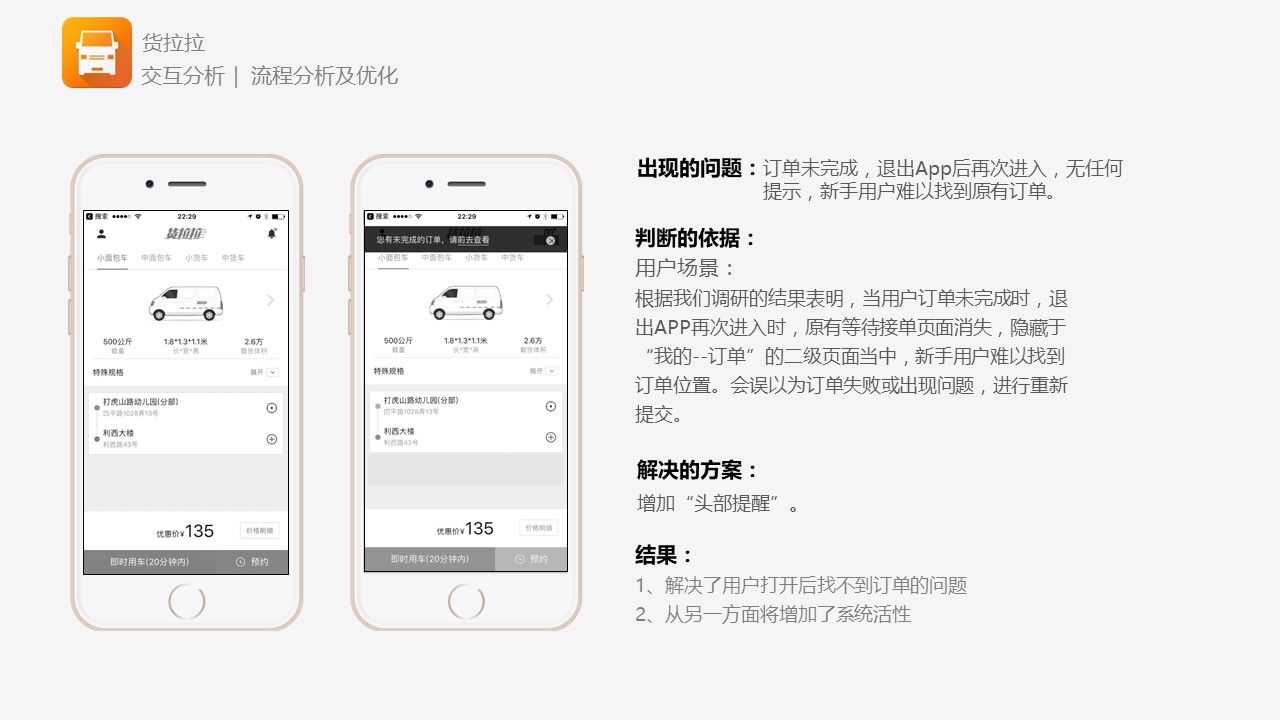
Users need to collect, and products attach importance to collection, but it is still not perfect.
From the research (in the modeling of self-employed individuals or small freight companies surveyed by users), we draw the conclusion that the collection of routes is a function that small B-end users are very concerned about and should also pay attention to. The function of collecting routes by freight Lala is not particularly perfect. In the second part, we improve the collection function to make it finish.
In this page, we can also prove that our research is accurate. Not only the users of the small B-end attach great importance to the function of "collecting routes", but also the cargo girl herself attaches great importance to the function of "collecting routes", and the function of "collecting routes" appears in many pages.
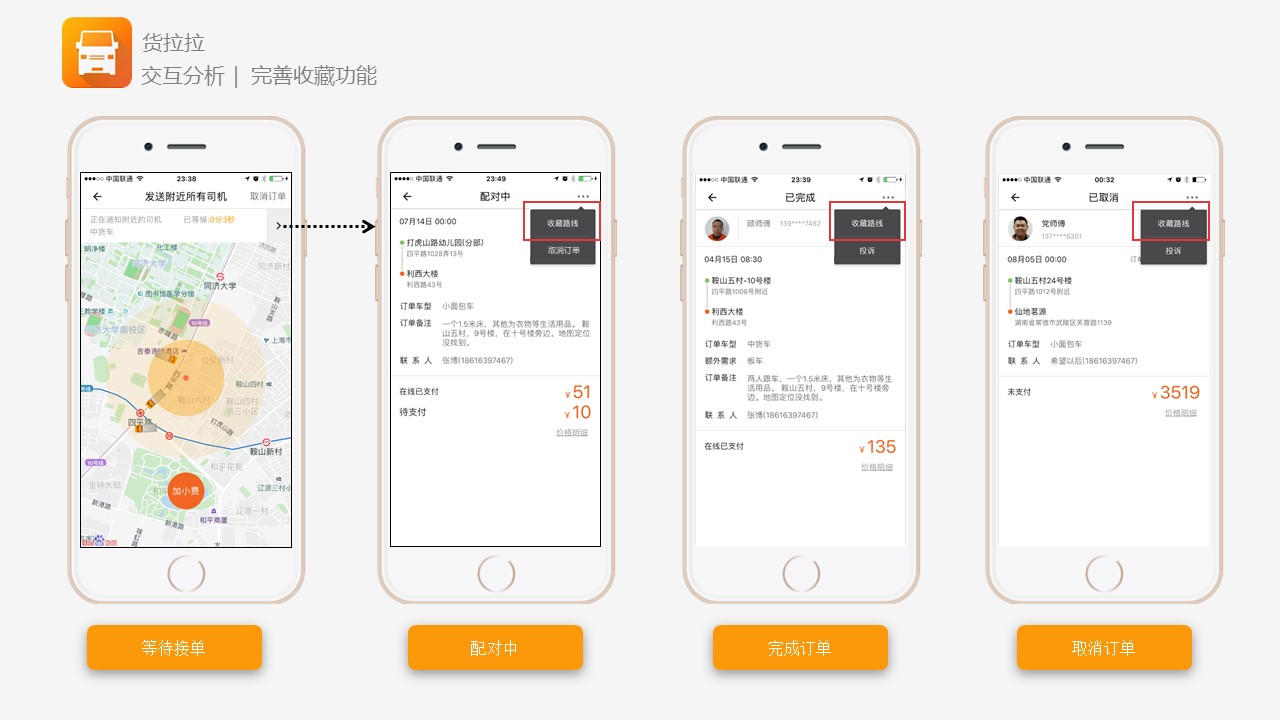
The problem is that there is no beginning and no end, and the collection page cannot be found.
I collect routes, and when I want to use them, I find that I can’t find my collected routes ~
Just now, we talked about the necessity of collection. Let me add one more point here. In the user survey, self-employed individuals and some small companies have the demand for collection routes. Because there are fixed customers and fixed addresses, it is necessary to collect routes.
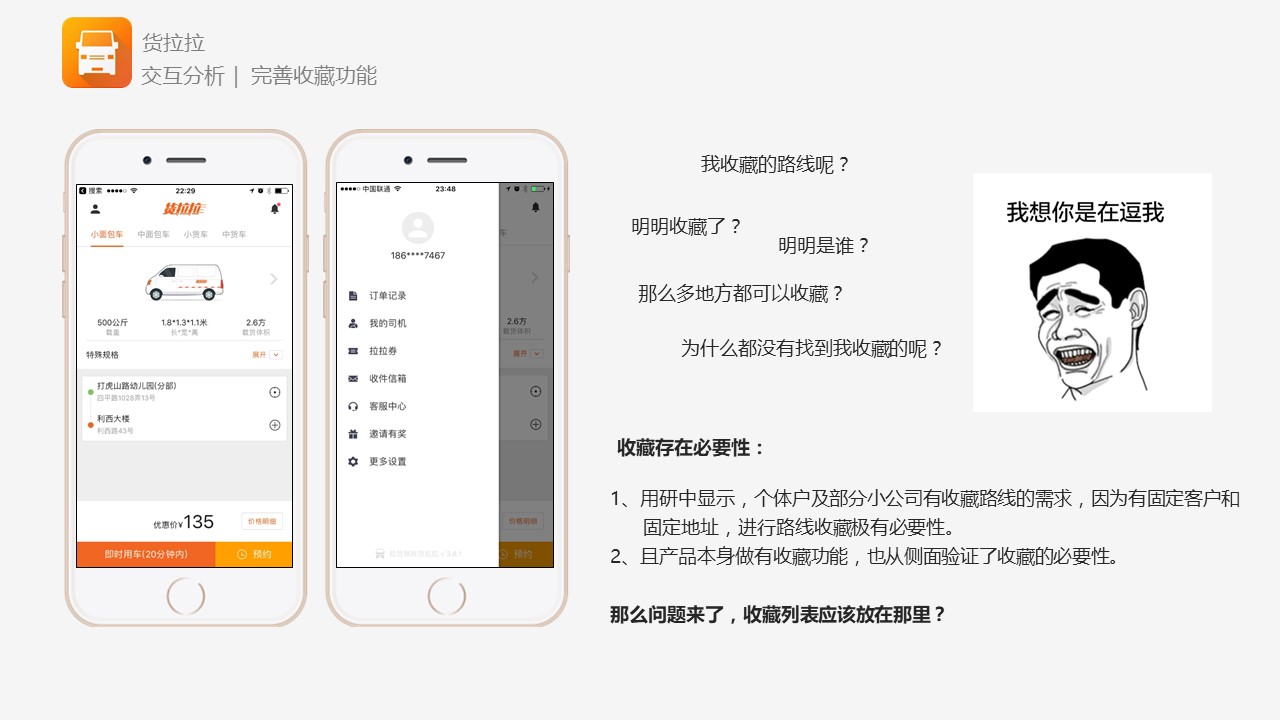
Summarize and propose solutions.
There is a problem:There is a collection function, no collection list, a beginning and no end.
Judgment basis:
- The necessity of the existence of collection, we talked about the reasons in the previous investigation;(in character modeling and scene modeling)
- In the early stage, a large number of places had the collection function, which could keep the data well, which was considered as a more intimate experience, but the collection list could not be found, which made the experience decline.
Solution:The Favorite Route is placed below the input address.
Effect (reason):
- Responding to the collection in front, we have achieved the beginning and end, improved the experience and improved the product process.
- It is placed below the input address, which is convenient for users to find the list at the first time and select the collection route, thus improving the efficiency of user operation.
- Conform to the design principle of efficiency first as a tool product.
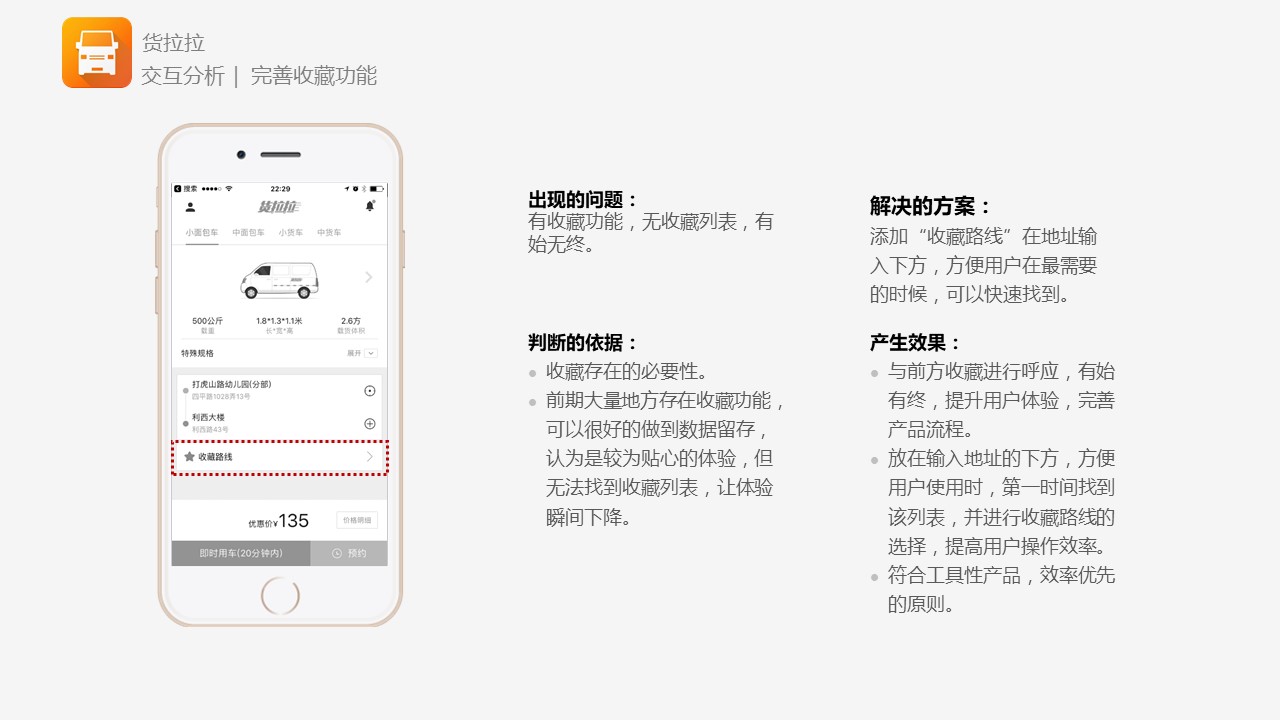
Quick contact selection or change-analysis of existing processes
When placing an order, when filling or changing contacts in Part 2, you can click Address Book–Enter Address Book List–Enter Contact Details Page–Select Contact Phone–and complete the number replacement.
So what happens when we enter the contact details page?
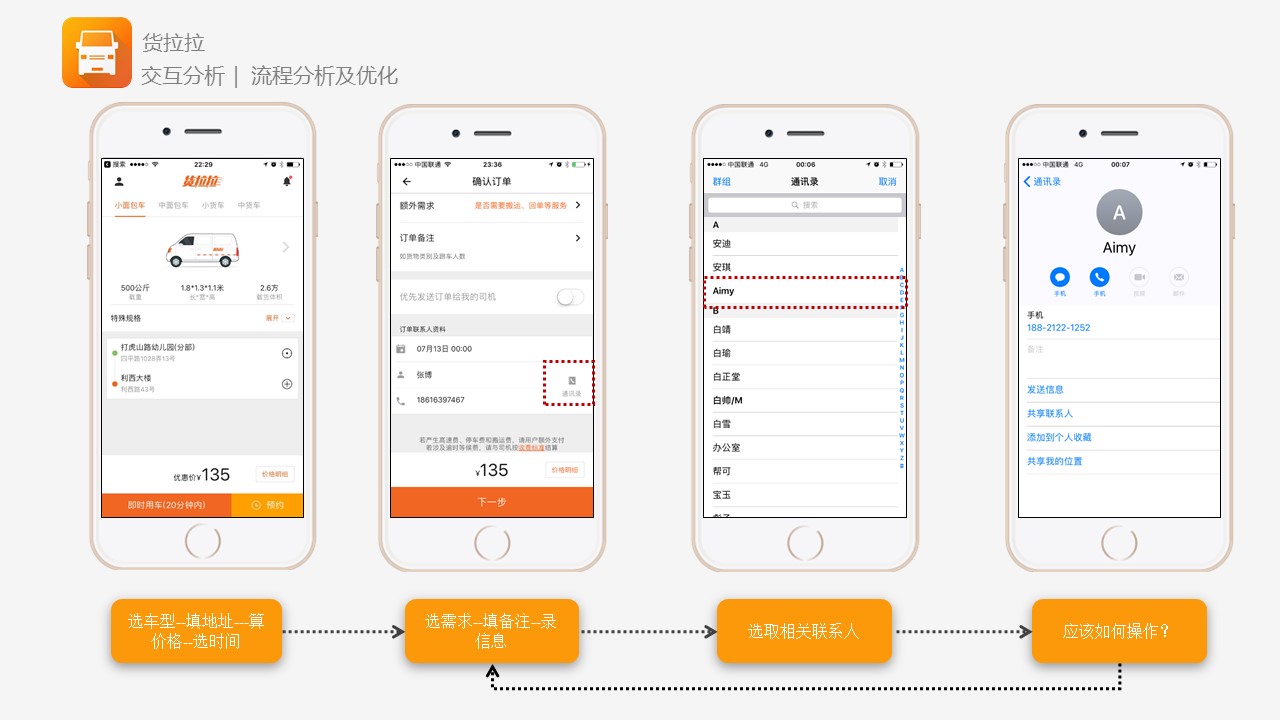
When entering the contact details page, what will the user do and what problems will arise? –heavy operating load
There is a problem:After entering this page, the operation is too large. Dare you call the phone number? Users are generally afraid to click, because of the cognitive inertia of IOS, click on the phone number = dial.
Judgment basis (user test and scene judgment):We did a test, five people used this function, three people selected long press on this page to copy, and then returned to confirm the order to paste, and two people clicked the mobile phone number to complete the replacement, and five of them had doubts and hesitation in this link.
Special consideration:We may say why we can change the number without directly accessing the phone number in the address book list and entering the details page. If so, it will be very troublesome when there are two numbers in one name.
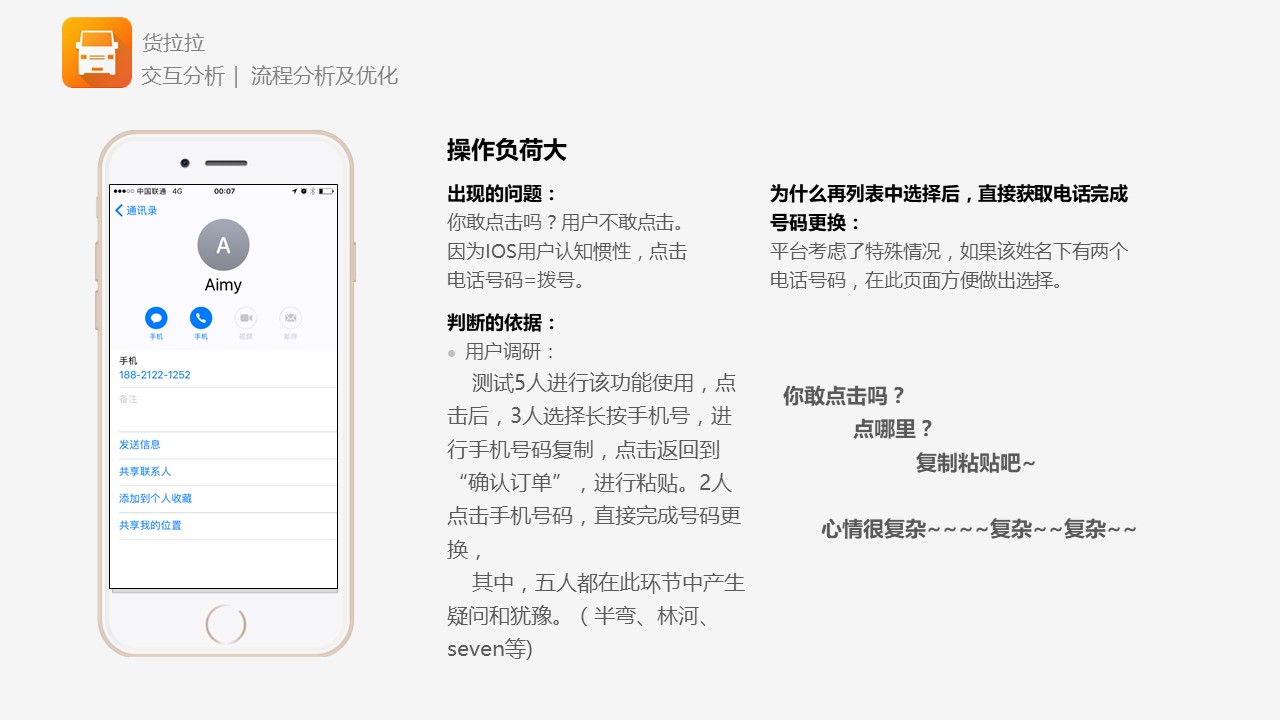
Modify the scheme-self-send address book display style
Modification scheme and feasibility:
At this time, we thought, since we can get the phone’s address book and the details page of the address book, can we get all the phones in the address book directly? The answer is yes.
We will get the phones in the address book in the mobile phone and rearrange them. We will judge the entries with multiple numbers in a person’s name. After the judgment is successful, we will fully display the information and redesign the address book in the APP. As shown below:
Effect:
- Reduce operation steps and improve operation efficiency; At the same time, the situation of operating load in the original design is avoided.
- The name and phone number are displayed at the same time, which makes the information clearer and helps to make the right choice at one time.
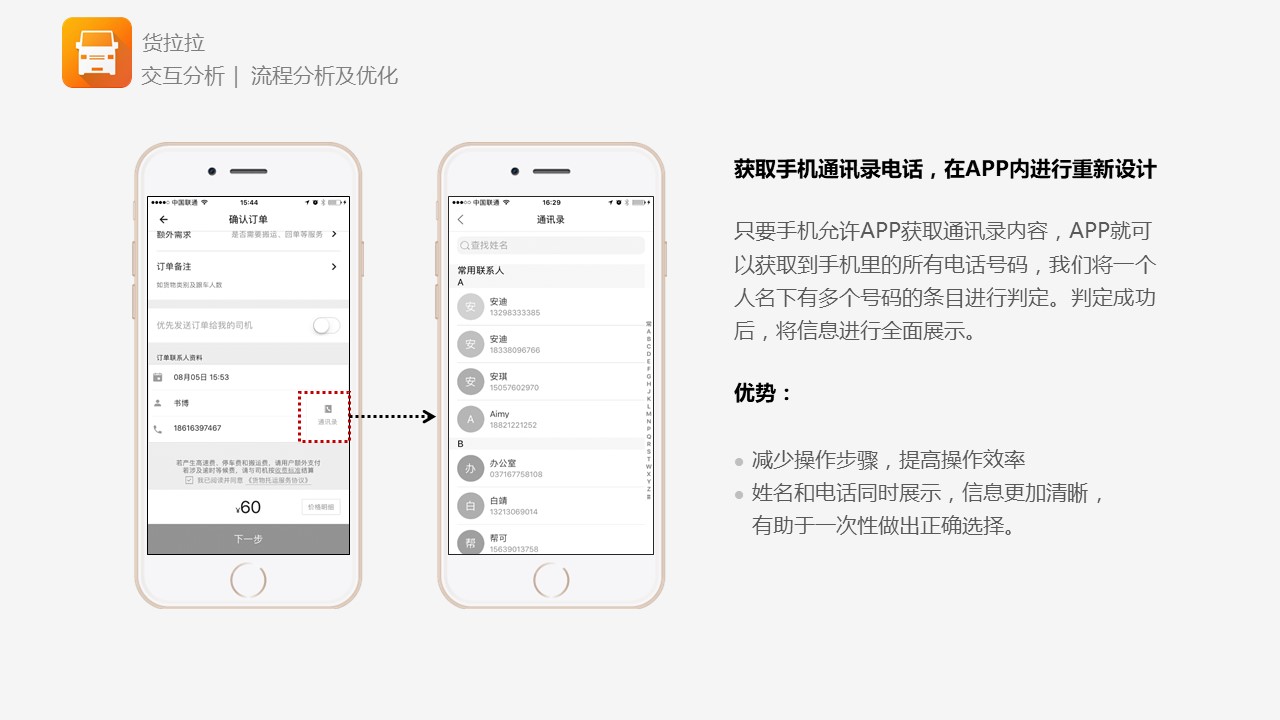
OK, that’s all for the product overview and some product optimization. Because of the time, we have to make a short summary next.
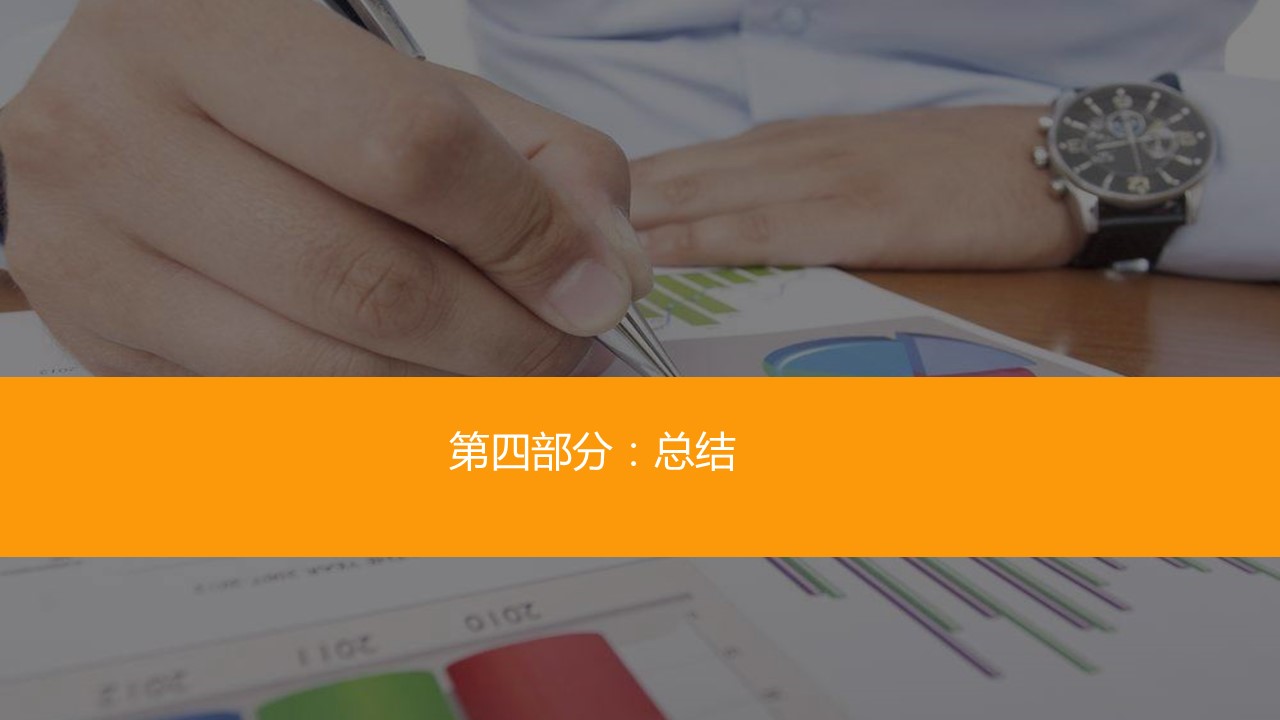
Simple summary:
From our above product introduction, analysis and optimization, we can be sure that the products of Cargo Lala are relatively good in terms of core functions and core processes, although some details can be made more perfect. On the user side, the number of users of cargo Lala is relatively above the average level in the industry. On the user side, we need to further expand publicity and further accumulate users. Freight Lala has a certain group cognition, but it is still on the road of freight transportation in the same city, making continuous efforts ~
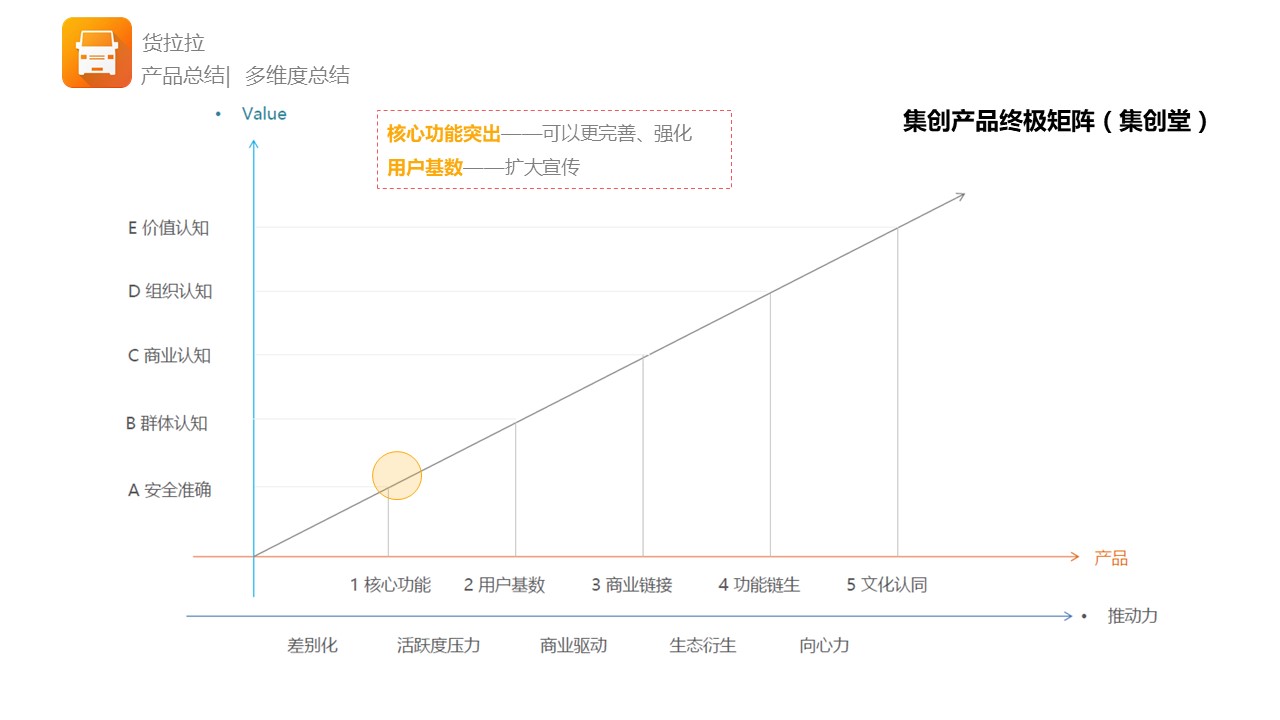
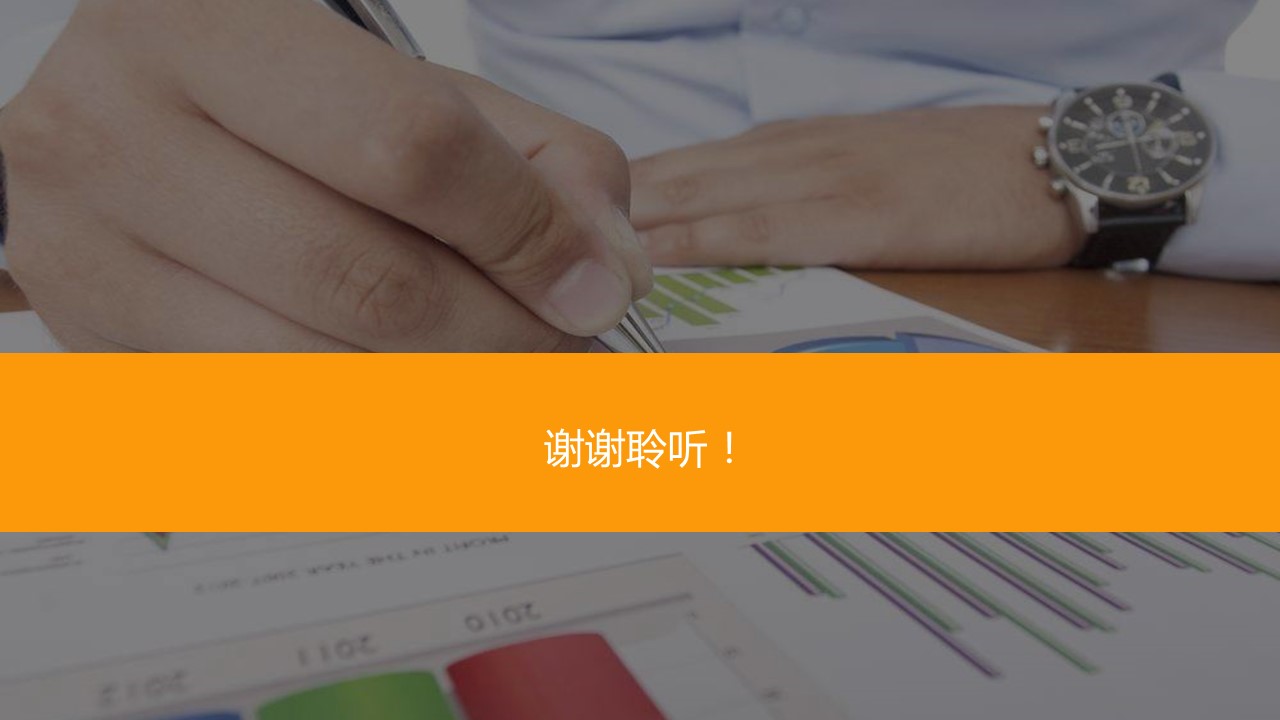
The commercial exploration and product-level thinking of cargo Lala will be elaborated in the next article. Please pay attention to the next article "Product Analysis: Cargo Lala APP-–(Product Q&A and Thinking)".
This article was originally published by @ Shubo. Everyone is a product manager. Reprinting is prohibited without permission.
The title map comes from PEXELS and is based on CC0 protocol.